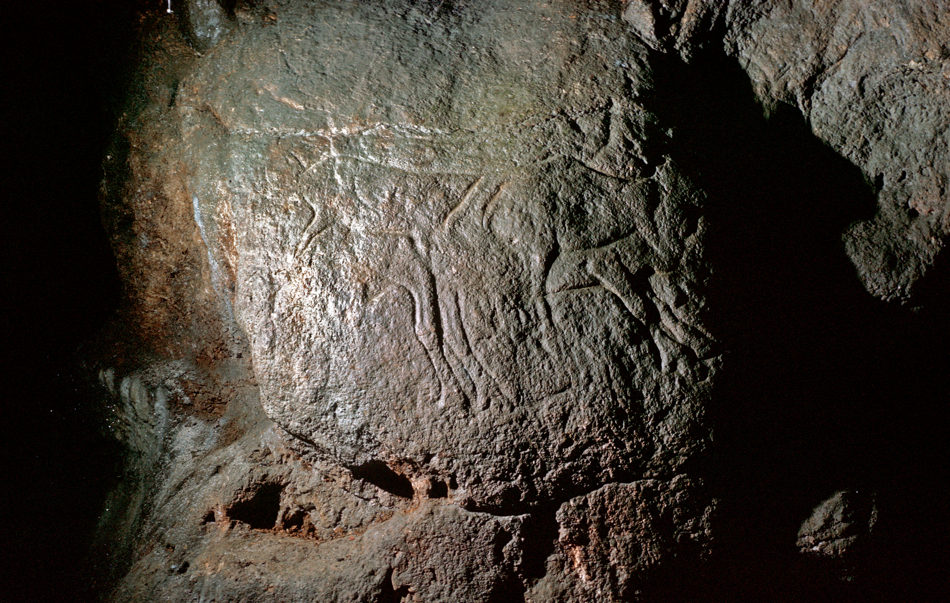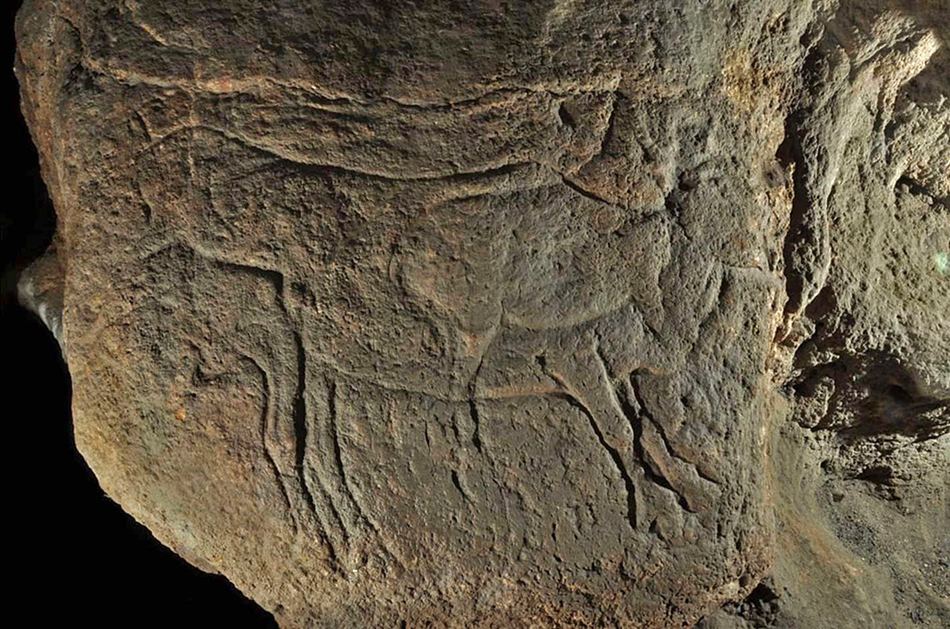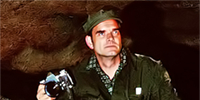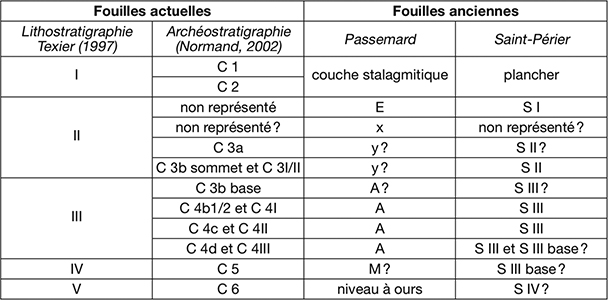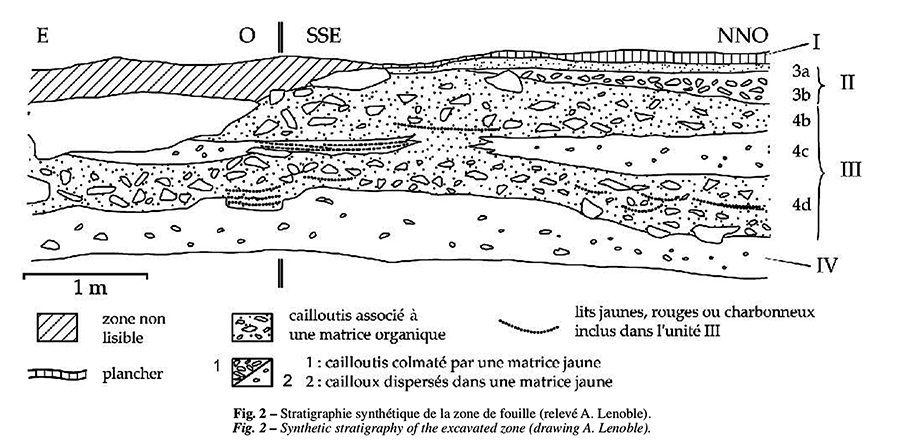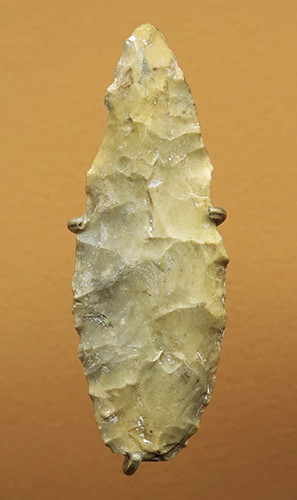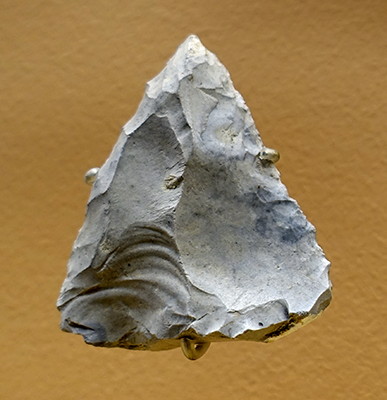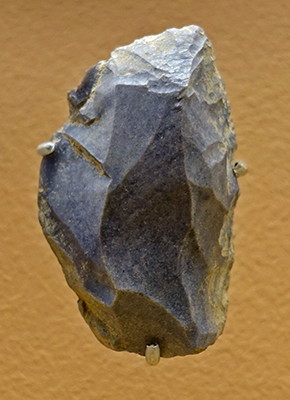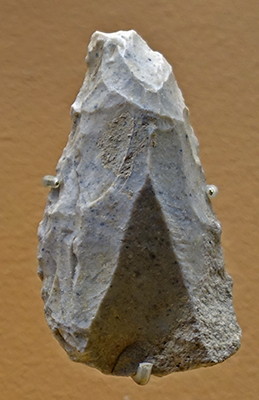Back to Don's Maps
 Back to Archaeological Sites
Back to Archaeological Sites
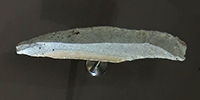 Tools from Isturitz
Tools from Isturitz
Isturitz, Oxocelhaya and Erberua Caves, where many prehistoric flutes were found
The Caves of Isturitz, Oxocelhaya and Erberua date back to the Mousterian, about 80 000 BP, and there is evidence of Neanderthals living there, but occupation extended to almost the end of the ice age in 10 000 BP. It is in the Atlantic Pyrenees region. The network consists of three caves, the upper Isturitz Cave, then 20 metres below, Oxocelhaya Cave with calcite concretions and finally the Erberua cave where the Arberoue river now runs. The main entrance to the cave Isturitz was known in medieval times. It is distinct from the current entry, created later. The first prehistoric objects were found at the end of the nineteenth century. Isturitz is famous for the discovery of a series of important prehistoric flutes dating from the Upper Paleolithic (Aurignacian to the Magdalenian), about 35 000 to 10 000 BC. The Périgordien period accounts for two thirds of the discoveries. There are also bone harpoons, figurines of bison on a sandstone plate (Magdalenian), and heads of propulseurs or spear throwers made of reindeer antler from the Middle Magdalenian. René de Saint-Perier excavated there in the early twentieth century. The caves also contain carvings and cave paintings, but only Isturitz remains accessible to the general public.Text above translated and adapted from the French Wikipedia.

Ticket Office and entrance to the Cave of Isturitz.
Photo: Don Hitchcock 2014


Entrance to the cave, and a closeup.
The door has been painted in trompe-l'oeil, representing visitors entering the cave when the doors are closed.
Photo (left): Krijun
Permission: Creative Commons Attribution - Share Alike 3.0 Unported
Photo (right): From the owner of the cave, via Google Earth.
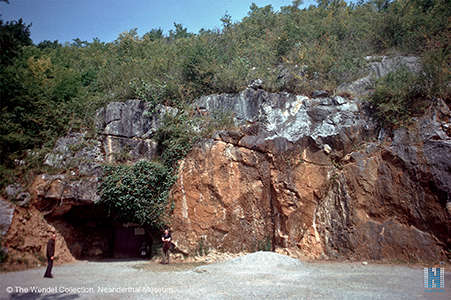
The entrance was not much different in the 1970s, when this photograph was taken.
Photo: Heinrich Wendel (© The Wendel Collection, Neanderthal Museum)
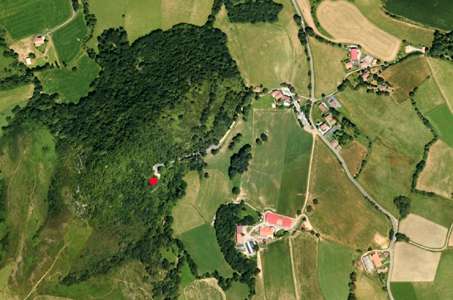
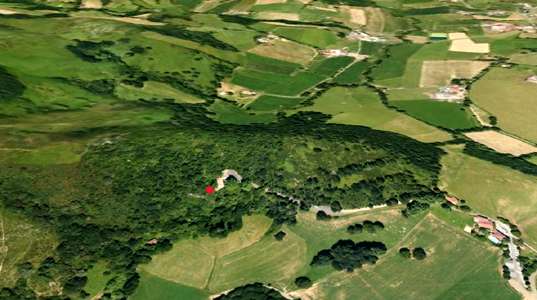
(left) view from above, (right) view showing perspective.
Photo: Google Earth.
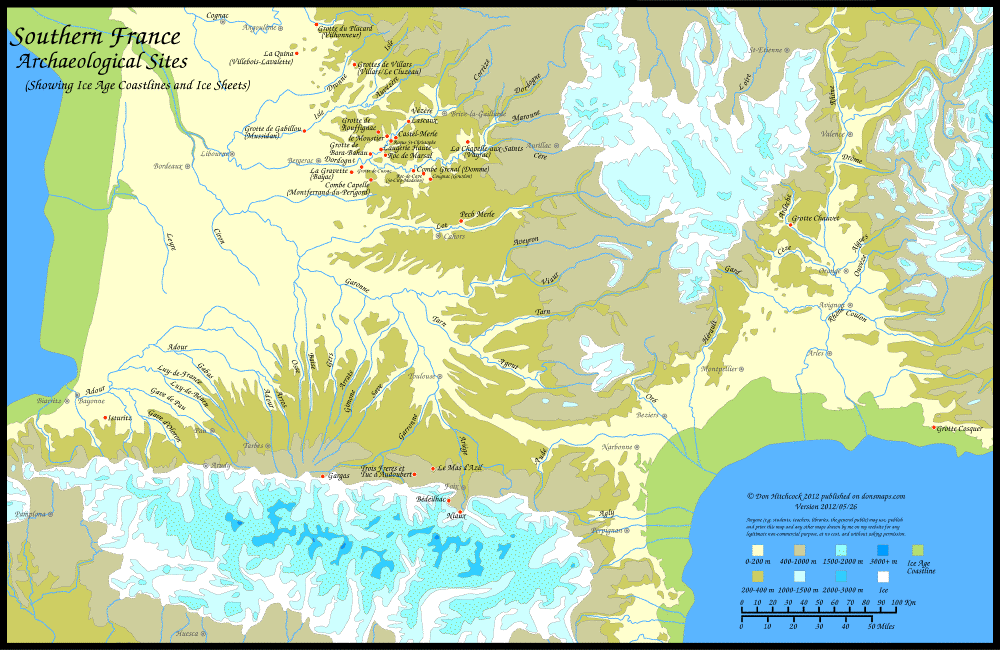
Note - Use this pdf file if you wish to print this map on a single sheet of paper.
Photo: Don Hitchcock version 2012/05/26
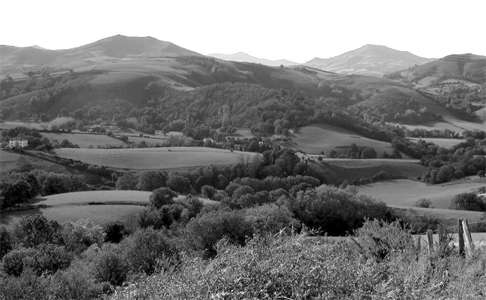
The hill of Gaztelu, the wooded hill in the mid foreground.
Photo: Normand (2005)


Two excellent photographs of the Erberua, from Alain Perre, via Panoramio, Google Earth.
M. Perre has many high quality photographs of similar entries and exits of streams, mostly in France, on Google Earth.
(left)
This shows the disappearance of the stream of Erberua into the tunnel which passes under the limestone hill of Gaztelu, on which the cave of Isturitz is situated. The ancient Erberua was responsible, some millions of years ago, for the formation of the cave of Isturitz.
(right) Here we see the Erberua reappearing on the other side of Gaztelu Hill, through a grille.
Photo: Alain Perre, via Panoramio, Google Earth
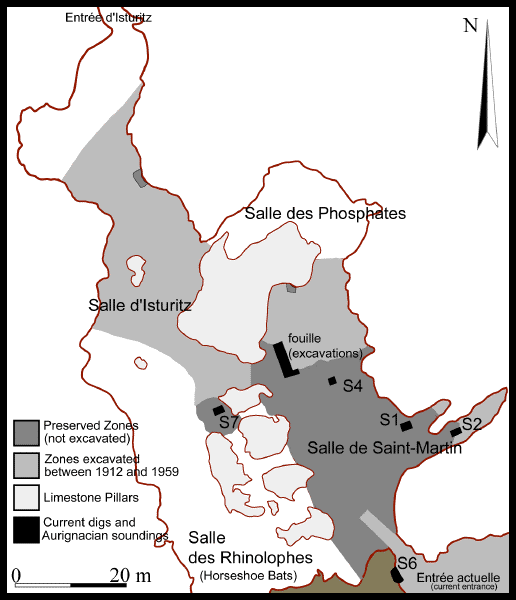
Plan of the cave of Isturitz.
Photo: Redrawn by Don Hitchock, after Normand (2005)

Plan of Isturitz.
Photo: Diego Garate based on Laplace (1984)
Source: http://www.mdpi.com/2076-0752/2/4/253/htm

Transverse diagram of la Salle Nord, including the engraved pillar.
La Salle Nord is also known as la Salle d'Isturitz or la Grande Salle.
Photo: Don Hitchcock 2014
Source: Display, Grottes d'Isturitz et Oxocelhaya
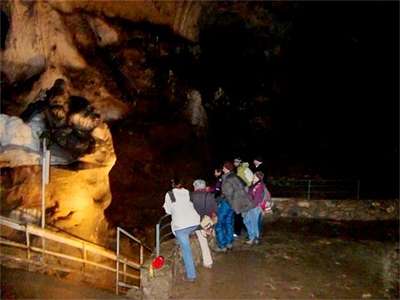
Inside Isturitz at the carved pillar.
Photo: http://www.grottes-isturitz-espaceculturel.com/

Sequence of occupations at Isturitz.
Photo: Don Hitchcock 2014
Source: Display, Grottes d'Isturitz et Oxocelhaya
Sequence of occupations at Isturitz
• 80 000 to 65 000 BP: First phase of occupation by Neanderthals during the Middle Palaeolithic.
• 65 000 to 55 000 BP: Occupation by Cave Bears.
• 55 000 to 45 000 BP: Second phase of occupation by Neanderthals.
• 45 000 to 35 000 BP: Transition period, the first phase of occupation by modern man during the upper Palaeolithic.
• 35 000 to 30 000 BP: Aurignacian, three phases of occupation.
• 30 000 to 25 000 BP: Gravettian, two phases of occupation.
• 25 000 to 20 000 BP: Solutrian, two phases of occupation.
• 20 000 to 15 000 BP: Magdalenian, two phases of occupation.
• 15 000 to 10 000 BP: Azilian, one phase of occupation.
• 10 000 BP to the present day: Neolithic, Mesolithic, Bronze, Gallo-Roman and Mediaeval ages.
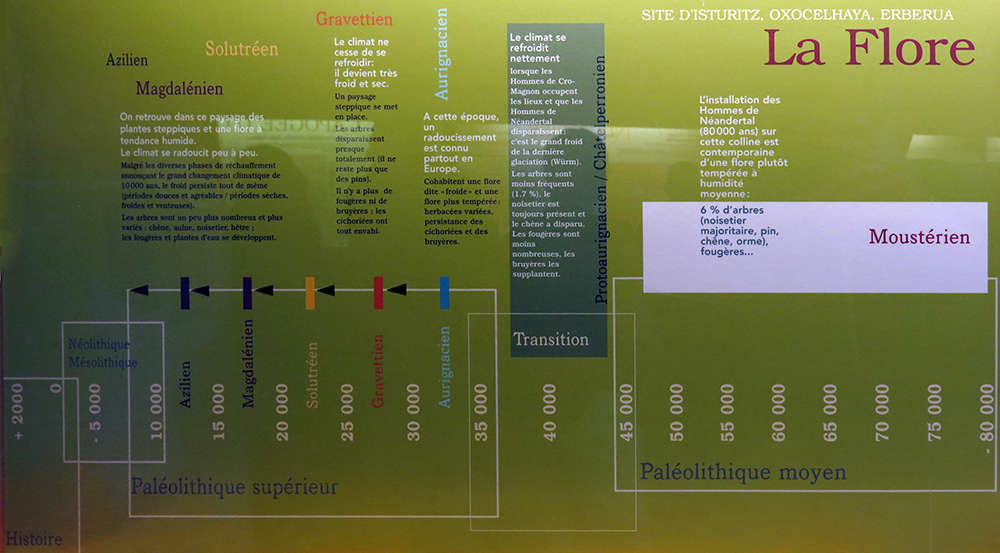
Flora at Isturitz during successive periods.
Photo: Don Hitchcock 2014
Source: Display, Grottes d'Isturitz et Oxocelhaya
• 80 000 to 45 000 BP: During the occupation of the cave by Neanderthals, the hill had vegetation consistent with a mostly temperate and well watered environment. 6% of the pollen found was from trees, with the majority being hazel nut trees plus pine, oak, and elm, as well as ferns.
• 45 000 to 35 000 BP: During this transition period, the climate cooled significantly. When Cro-Magnon man began to occupy the premises and the Neanderthals disappeared, it was the time of the extreme cold of the last glaciation, the Würm. The tree pollen is less frequent (1.7%). Hazel nuts are still present but the oaks have disappeared. Ferns are less numerous, and were supplanted by heathers.
• 35 000 to 30 000 BP: During the Aurignacian, milder temperatures occurred throughout Europe. However there were both 'cold' and 'temperate' plants existing at the same time. Daisies and heathers persisted.
• 30 000 to 20 000 BP: During the Gravettian and the Solutrean, the climate continued to cool. It was very cold and dry. A steppe landscape took over. Trees disappeared almost completely, leaving only scattered hardy pines. There are no more ferns or heathers, only daisies and cold tolerant grasses. .
• 20 000 to 10 000 BP: During the Magdalenian and Azilian, the climate softened gradually, and steppe plants and flora adapted to wetter conditions invaded the area. Despite the various phases of warming which preceded the great climate change at 10 000 years, cold persisted all the same, interspersing warm and agreeable conditions with dry, cold and windy times. Trees became a little more numerous and varied: oak, alder, hazel and beech. Ferns and water plants became an important part of the biome.

The Occupation of the cave
Men not only moved camp during the year, but within the cave they moved over longer periods from one part of the cave to another, depending on the climate outside and the changes in the form of the cave due to rockfalls.
The six plans show, respectively, the occupation during:
1: The Middle Palaeolithic occupation by Neandertals
2: The Upper Palaeolithic Aurignacian occupation
3: The Late Aurignacian
4: The Gravettian
(The Solutrean barely represented, not shown on this set of maps)
5: The Middle Magdalenian
6: The Upper Magdalenian
• Neanderthals first occupied the cave in the south, benefiting from the sunshine which shone directly into the huge porch of the cave.
• Modern humans at first occupied the same place in the southern part of the cave, a time when there was a lot of activity at the hill of Gaztelu, with the area being a centre for trade and the economy of the northern side of the Pyrenees. Following rockfalls from the roof, the last Aurignacians moved to the Grand Salle d'Isturitz, near the north entry, today closed by rockfalls.
• The Gravettians continued to exploit even more fully the same places.
• The Solutreans used only a small part of the cave, the same area as the last Aurignacians.
• In the Middle Magdalenian, men used the whole cave. The two main salles were both occupied.
• In the Upper Magdalenian, the Salle Saint-Martin was abandoned, and the Salle d'Isturitz was the only area occupied, near the northern entrance.
Photo: Don Hitchcock 2014
Source: Display, Grottes d'Isturitz et Oxocelhaya
The Isturitz cave has a general northwest/southeast orientation. Probably, originally it was a very wide gallery, more than 120 m long and up to 50 m wide in some places, open at both ends. Successive collapses progressively sealed off the southeast entrance, through which the Arberoue River entered. The entrance from the other direction also was affected by rock fall that did not close it totally.Text above: Garate et al. (2013)
Based on the various observations made, the corresponding porches or rock-shelters must have had imposing dimensions, especially the one located on the side of the town of Saint-Martin-d’Arberoue, oriented to the SW. Our observations on the shape of this entrance at the beginning of the middle Paleolithic suggest a width between 15 and 20 m and a height of close to 10 m. Such an opening would definitely have been visible from far away and could have, very early on, attracted the prehistoric populations who spent time in the valley.
However, during this period of history, only the entrance located in the town of Isturitz was usable; this fact explains the name of the cavity, although most of its area is in Saint-Martin-d’Arberoue.
The Isturitz cave network is generally divided into two parts: the Hall of Saint-Martin (or South Hall) and the Main Hall or Hall of Isturitz (or North Hall). In this paper we suggest the addition of two “adjoining” halls: the Rhinolophus Hall and the Phosphate Hall, as well as various small adjacent galleries connecting the various sectors.


These cranial vaults may be examples of cannibalism, and of the use of the bones as drinking cups.
Bello et al. (2011) state:
'Similarly at Isturitz, four calottes have been described as 'coupelles', Buisson et Gambier (1990). These have also been intensively cut-marked, carefully broken in order to preserve most of the upper portion of the vault, and the broken borders made regular and in some cases polished. In some remarkable cases, the calottes were engraved with animal representations (Buisson et Gambier (1990), Fig. 2, 3 pages 173–174).
Le Mort (1981) suggested that the modifications (preparation of skull-cups and engraving) were produced immediately after the bodies were actively defleshed.'
Photo: Don Hitchcock 2014
Source: Originals or very good quality facsimiles, display, Grottes d'Isturitz et Oxocelhaya
Bas relief of a group of animals including a large reindeer, on the Engraved Pillar of the Isturitz Hall .
Photo (above): Heinrich Wendel (© The Wendel Collection, Neanderthal Museum)
Photo (below): http://www.mdpi.com/2076-0752/2/4/253/htm
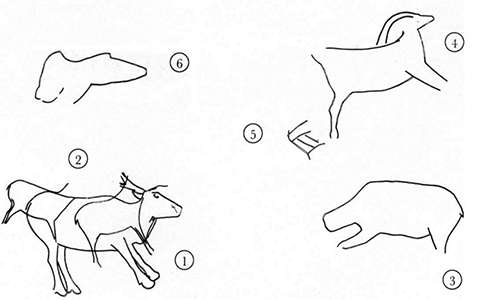
Drawing of the figures above.
Photo: Heinrich Wendel (© The Wendel Collection, Neanderthal Museum)
Source: Laplace (1984)
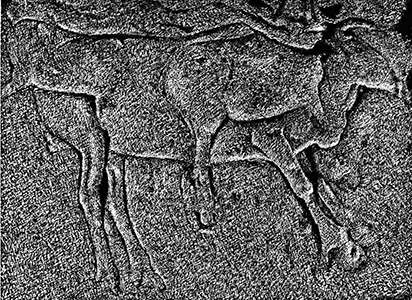
Cast of the pillar.
Photo: Passemard (1918)

View of the Large Pillar from the platform from the other side of the stairway towards Oxocelhaya
Photo and text: http://www.mdpi.com/2076-0752/2/4/253/htm
The figure of the large reindeer, which occupies almost the entire panel, is probably the most elaborate of the representations of the Large Pillar. It presents a large number of details; neckline, eye, ear, double line of the breast, cloven hooves, muscular insertions of the back legs and knees, and it is the only one that has two legs per pair in this set.
Nonetheless, certain parts were not completely finished: the lines of the hindquarters and the tail. One possible explanation is the hypothesis that we proposed above concerning the erroneous figuration of the line of the back.
With regard to the snout, it was not conserved because of removals from the wall, but it is possible that it was also originally represented.
Text above: http://www.mdpi.com/2076-0752/2/4/253/htm
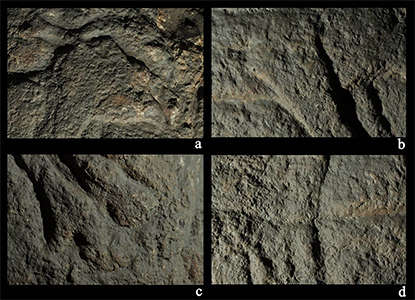
Details of the figure of the large reindeer.
a) Macro view of the head. The impacts on the level of the snout, which probably destroyed it, are easily visible.
b) Differential relief of the front legs of the large reindeer.
c) Detail of the cloven hooves of the front legs.
d) Superposition of the line from the belly to the back leg of the first deer.
Photo and text: http://www.mdpi.com/2076-0752/2/4/253/htm
One of the more specific characteristics of the Isturitz cave is the large quantity of objects inserted in the walls. In all, 280 deposits were inserted in four distinct halls: the Rhinolophes hall, the Large hall, the Saint Martin hall and the Phosphates hall. In each hall, three zones can be distinguished: a major zone with most of the deposits, a secondary zone where the deposits are still associated although more scattered, and a minor zone in which deposits are isolated and not very numerous or even alone.Text above: http://www.mdpi.com/2076-0752/2/4/253/htm
There are four types of deposits: flint artefacts, all of which have been knapped, very small fragments of bone, rarely worked and sometimes fractured, colouring materials of different tones and rather rough particle size and, exceptionally, animal teeth.
The containers are of three types: fissures, which contain most of the deposits, then holes and lastly entablatures. The placement in the containers appears to be random and is, based on the current data, rather heterogeneous.
The deposits are often near colorations on the wall, or in the solid colour areas. However, none of these deposits has coloration, neither at the base nor at the summit, nor covering them. Sometimes the fissures have traces of colour washing, but the deposit remains free of coloration. Such an observation allows us to consider a deposit after the making of the solid colour area, when the coloration was already applied and dry.

Various types of inserted objects in the Isturitz cave: flint, bone, ochre and teeth.
Photo and text: http://www.mdpi.com/2076-0752/2/4/253/htm
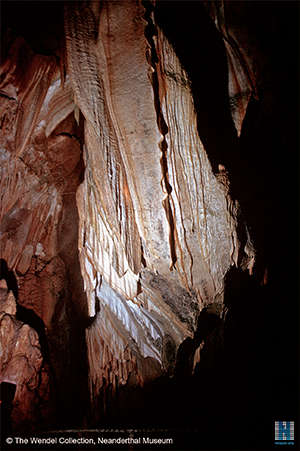
Flowstone in the cave.
Photo: Heinrich Wendel (© The Wendel Collection, Neanderthal Museum)

Stalactites and stalagmites inside the lower cave of Oxocelhaya.
Photo: Brochure from http://www.grottes-isturitz.com/grottes-isturitz/calendrier_gb.htm
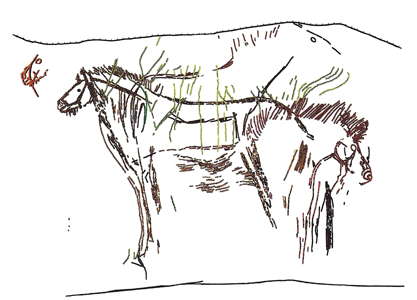
Drawing of a horse, apparently wearing a halter.
Photo: Larribau (2011)
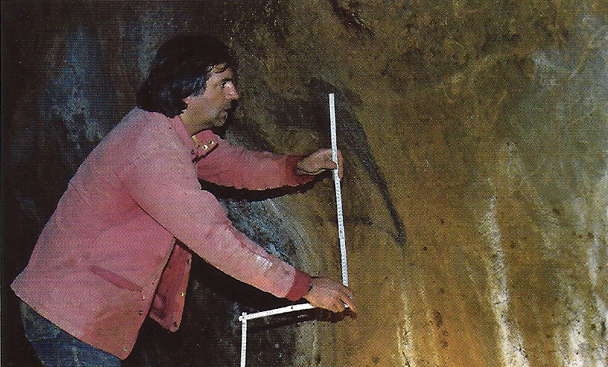
Jean-Daniel Larribau, researching the art of the cave of Oxocelhaya.
Photo: Larribau (2011)
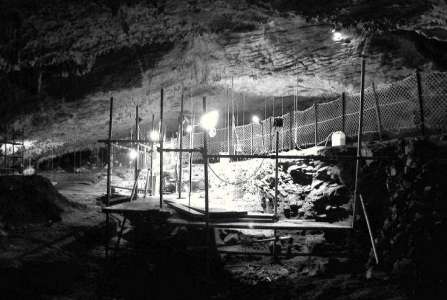
The excavation site at Salle de Saint-Martin
Photo: Normand (2005)
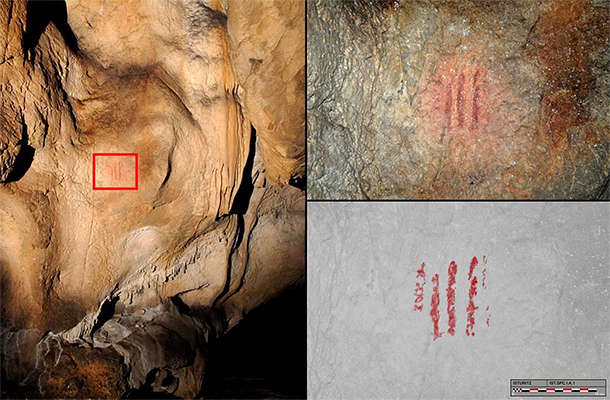
Vertical lines in the Sepulchral hall of the Salle de Saint-Martin.
Photo: http://www.mdpi.com/2076-0752/2/4/253/htm

Dots and marks in the Large Chamber of the Salle de Saint-Martin.
Photo: http://www.mdpi.com/2076-0752/2/4/253/htm
La grotte ornée d'Erberua (Pyrénées-Atlantiques). Note préliminaire
Larribau et Prudhomme (1983)
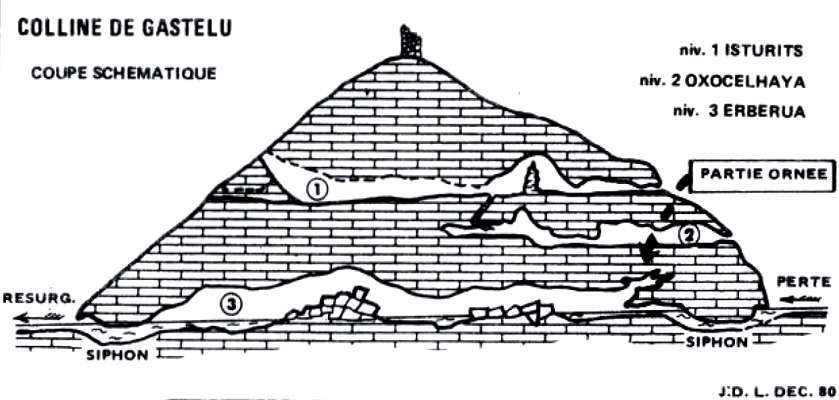
Diagram of the three caves, with Isturitz at the top, Oxocelhaya below that, and the Erberua Cave at the base of the hill, with the Erberua river passing through it. Access to the Erberua cave and its decorations is only by swimming through either of the siphons, using scuba gear.
Photo: Larribau et Prudhomme (1983)
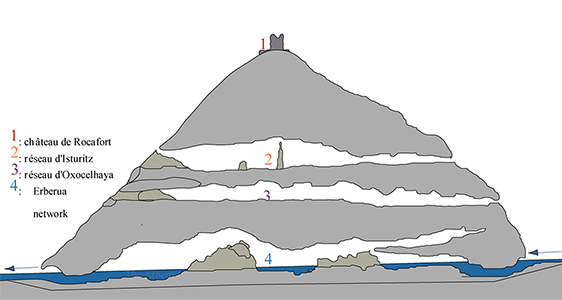
Gaztelu hill cross section.
Photo: http://www.mdpi.com/2076-0752/2/4/253/htm
The upper Isturitz cave was excavated by M. Passemard and M and Mme de Saint-Perier. This cave was frequented and inhabited continuously from the Mousterian to the final Magdalenian.
According to Abbé Breuil, it is the beginning of the Magdalenian IV when the bas-reliefs of Isturitz were made. M. Leroi-Gourhan puts them somewhere between the Middle and Late Magdalenian (Style III). They represent 2 reindeer, 2 deer (or two goats according to the authors), a horse (or 2), a bear and a mammoth (according to M. Leroi-Gourhan).
In the middle is the Oxocelhaya cave. In 1955 and 1956, the work of Abbé Barandiaran and MM Boucher and Laplace mentioned a few 'rare Mousterian pieces' and some more recent tools of the Neolithic, in the first room of this cavity. In addition, M. Laplace was to discover, in 1955, a decorated gallery comprising:
- 'Three head and shoulders of horses and a bird's head, obtained by scraping the rock.
- an horse, a head of a horse, and a bison painted with black lines.
- The back of a horse and a female deer, deeply engraved.'
The cave of Erberua corresponds to a lower active level where the creek called Arberoue flows. This stream caused the formation of the three cavities, and disappears at the foot of the limestone hill 'Gastelu' and reappears after flowing underground for more than 300 metres. The two siphons at each end of this course impede access and protect the cave.
Of the first 150 metres following the downstream siphon, the cross section of the cavity is similar to the contours of a "keyhole" 15 to 20 metres high. Indeed, in the upper part, the gallery is large, while it narrows at the bottom where the river flows underground.
Halfway through, a tributary whose flow was estimated at 0.13 m3 / s in low water comes in from a large secondary gallery (10 mx 15 m) which enters on the left bank of the main cave. This annex is part of ongoing exploration. Then the cavity becomes more circular, as it progresses towards the upstream trap.
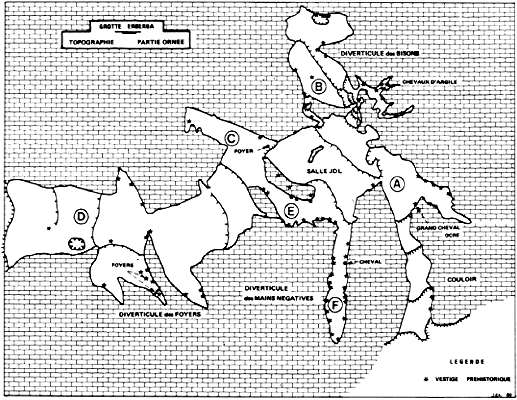
Map of the decorated section of Erberua Cave.
In the terminal area of 50 m before the siphon, many galleries open into the upper parts of the cavity including one where wall drawings and objects on the floor were discovered recently.
Photo: Larribau et Prudhomme (1983)
Les Occupations aurignaciennes de la grotte d'Isturitz (Saint-Martin-d'Arberou; Pyrénées-Atlantiques; France)
Normand (2005)
Isturitz is located in the foothills of the Western Pyrenees, about thirty kilometres from the present shoreline of the Atlantic Ocean, and a short distance from the Pyrenees, the first peaks of over 1000 metres are only 25 km away.
The hill has an altitude of 209 m, and consists of a rocky limestone outcop 500 m long, by 300 m wide.
The Arberua River had dug three channels through the hill, the highest being Isturitz, then Oxycetalhya , then the tunnel through which the present Erberua still flows.
Isturitz is oriented generally north west to south east, and has a length of 120 metres, sometimes reaching a width of 50 metres, open at its two ends, although a succession of collapses gradually blocked the southern entry, and severely restricted the the one opposite.
It is commonly divided into two principal chambers, the Salle d'Isturitz (or the Grand Salle or the Salle Nord) and the Salle de Saint-Martin (or the Salle Sud).
The Salle d'Isturitz has a total area of more than 1700 m2 with a ceiling height sometimes as much as 15 metres. The Salle de Saint-Martin is significantly different: besides a smaller area, all altogether close to 1000 m2, it differs from its neighbour by a ceiling whose present height rarely exceeds 2 metres.
In the Hall of lsturitz, above the layers which only contain fauna has been encountered a sequence covering almost the entire Upper Paleolithic to the top of the Azilian and then Bronze Age graves on a large flowstone near the northern entry.
In the Hall of St. Martin, human use of the area starts with the Mousterian, more or less associated with the remains of cave bears, then continues with a rich ensemble of Aurignacian and Magdalenian deposits. Only a few pieces testify to Solutrean and Gravettian layers. As in the previous room Ia, human remains from the Bronze Age seal the archaeological sequence.
The material currently collected and preserved at the Museum of National Antiquities in Saint-Germain-en-Laye certainly includes tens of thousands of objects, often of very high quality (flutes, baguettes demi-rondes with curvilinear designs, sculpture in the round ...), but it results from sorting, sometimes quite severe.
Indeed, some categories are very much under-represented, including fauna - the prevailing method was only to determine the main species and reject anything not considered useful - and the stone industry, which is virtually lacking all items of less than 3 cm, all waste and debitage, not counting very many tools abandoned in the debris. However, bone tools and pieces of art were much less affected. It must be admitted that several old collections have overall bias (stratigraphic misallocation understandable in this context, representativeness sometimes questionable ...) and it is imperative to approach with caution, taking into account their relative value whenever possible.
Excavations in the Saint-Martin chamber
From: Normand (2007)
New research conducted in the Saint-Martin chamber has revealed intensive Aurignacian occupations attributed to the archaic and early phases of this techno-complex. In this paper, we present a synthesis of the principal data that make Isturitz a key site in the study of this period.
Equivalences between the different stratigraphic profiles for the present and previous excavations in the Saint-Martin gallery.
Source and text: Normand (2007)

Travaux des phosphatiers - work of phosphate excavations
Fouilles Passemard - Excavations by Passemard
Fouilles Saint-Périer - Excavations by Saint-Périer
Témoins - witness section, left unexcavated for future archaeologists
Calcaire massif (paroi) - Limestone bedrock (walls)
Proximal source and text: LaCarrière et al. (2011), after Normand (2002)
Synthetic stratigraphy of the excavated zone.
Drawing: A. Lenoble
Source and text: Normand (2007)

Perforated human molar from level 3b.
Photo: R. White
Source and text: Normand (2007)
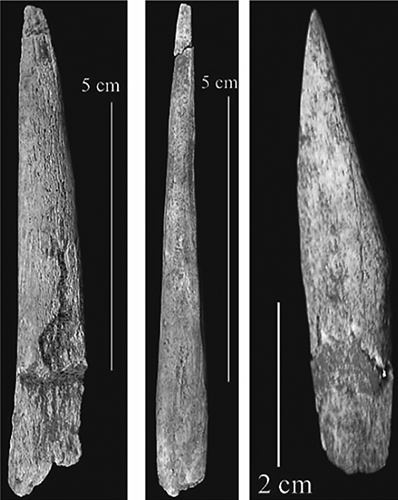
Split-based points from level 4b1.
Photo: N. Goutas
Source and text: Normand (2007)
| Flora and Climate | |||
|---|---|---|---|
| Layer | Sector | Flora | Probable Climate |
| C 3b (top) |
Principal excavation | Trees: 3.2% Pinus (pine), Betula (birch) Asteraceae (daisies) dominating the Poceae (grasses) |
Open, very cold, rather dry |
| C 4I | Coupe Cross Section/Trench |
Trees < 5% Pinus (pine), Betula (birch), Corylus (hazel), Quercus (oak), Alnus (alder) Poceae (grasses) dominating the Asteraceae (daisies) |
Open, not very cold |
| C 4II | Coupe Cross Section/Trench |
Trees: < 5% Pinus (pine), Alnus (alder) Poceae (grasses) dominating the Asteraceae (daisies) |
Open, moderately cold |
| C 4c1 | Principal excavation | Trees: 1.4% Pinus (pine) Poceae (grasses) dominating the Asteraceae (daisies) |
Open, rather cold, dry |
| Fauna NISP (number of identified specimens) and MNI (minimum number of individuals) of the animal groups |
|||||||||||
|---|---|---|---|---|---|---|---|---|---|---|---|
| Species | C 4b1 | C 4b2 | C4Ia | C 4II | |||||||
| NISP | % NISP | MNI | NISP | % NISP | MNI | NISP | % NISP | MNI | NISP | % NISP | |
| Bears | 2 | 0.3% | 2 | 4 | 2.3% | 2 | - | - | 2 | 1 | 2.2% |
| Wolf | - | - | - | 1 | 0.6% | - | - | - | - | - | - |
| Fox | 58 | 9.2% | 1 | 21 | 12.1% | 1 | 12 | 19.7% | 1 | 12 | 26.1% |
| Hyena | 4 | 0.6% | 1 | - | - | 1 | 1 | 1.6% | 1 | 1 | 2.2% |
| Undetermined carnivores | - | - | - | - | - | - | - | - | - | 1 | 2.2% |
| Deer | 3 | 0.5% | 1 | - | - | 1 | - | - | 1 | 2 | 4.3% |
| Reindeer | 140 | 22.2% | 3 | 37 | 21.3% | 3 | 23 | 37.7% | 3 | 4 | 8.7% |
| Indeterminate Cervids (Deer, Elk, Moose) | 4 | 0.6% | - | - | - | - | - | - | - | - | - |
| Megaceros | - | - | - | 1 | 0.6% | 1 | - | - | - | - | - |
| Large bovids | 71 | 11.3% | 2 | 14 | 8.0% | 1 | 7 | 11.5% | 2 | 7 | 15.2% |
| Horse | 347 | 55.0% | 6 | 94 | 54.0% | 6 | 17 | 27.9% | 3 | 18 | 39.1% |
| European wild ass | 1 | 0.2% | 1 | - | - | - | - | - | - | - | - |
| Mammoth | - | - | - | 1 | 0.6% | 1 | 1 | 1.6% | 1 | - | - |
| Hares, rabbits, pikas | 1 | 0.2% | 1 | 1 | 0.6% | 1 | - | - | - | - | - |
| Total | 631 | 100% | 18 | 174 | 100% | 18 | 61 | 100% | 14 | 46 | 100% |
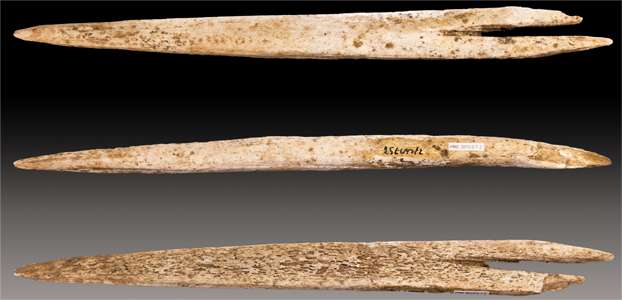
Three views of the same tip of a spear with a forked base found at Isturitz, Muséum de Toulouse.
Bone is preferable as a tip for many hunting purposes, as it is more shock resistant than flint, unless the sharpness of flint is specifically required in order to penetrate the tough hide of a mammoth or a wooly rhinoceros.
This type of point was split to facilitate binding it to the end of a spear, specially modified to accept the split, the whole then being bound with sinew or cord, and a coating of glue or pitch applied to the bindings.
Photo: August 17, 2010 (2010-08-17)
Source: Wikimedia Commons, Personal work, Didier Descouens
Authorization:
As the holder of copyright, I publish it under the following license:
This file is available under the terms of the Creative Commons Attribution - Share Alike 3.0 Unported identical
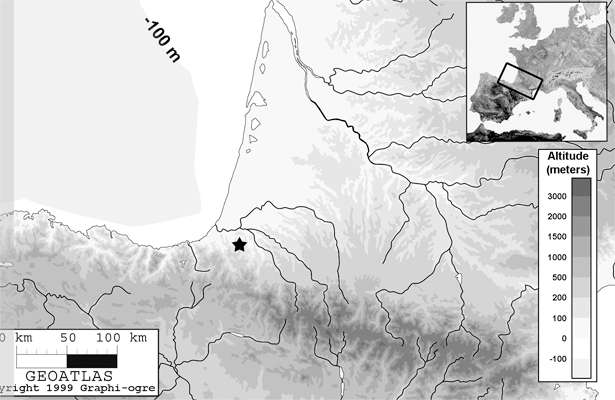
Map showing the relationship of Isturitz to the ocean shore, about 50 km distant, when the sea was 100 metres lower during the last ice age.
Whales regularly beach on the Bay of Biscay shores, as shown in the photo below, and would have provided bone for tools and spear points, as well as large quantities of meat for those who regularly patrolled the beaches. Whalebone tools may have had special significance or magic to the users, having come from such large animals.
Photo: Pétillon (2008)
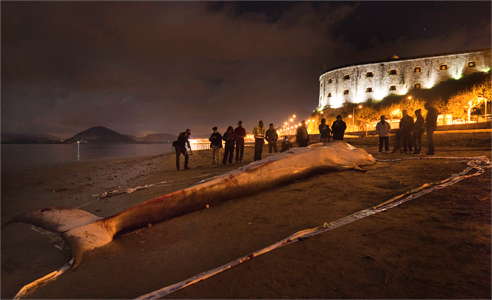
This ten metre long whale beached itself on the shore near the fortress of San Martin, on the Cantabrian coast of northern Spain, in November 2011.
Photo: Antuan Ayllón
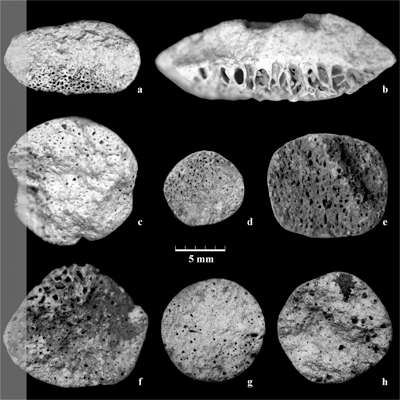
Cross-section views of an antler point fragment from Isturitz (a), a worked land-mammal rib fragment from Lespugue (b), and 6 whale-bone artifacts from Isturitz (c-h). On h, the dark
triangular shape is sediment staining.
Photo: Pétillon (2008)

Detail of the surface of 4 whale-bone artifacts, showing the orientation of the trabeculae. The trabeculae can be seen on all sides of the objects, and across their entire length.
a: proximal fragment of projectile point with simple, blunt base (layer II/E);
b: foreshaft proximal fragment (layer II/E);
c: wedge (layer I/F1);
d: fragment of unidentified object (layer SI/Eω).
(Note that a trabecula, plural trabeculae, from Latin for 'small beam' is a small, often microscopic, tissue element in the form of a small beam, strut or rod, generally having a mechanical function, and usually composed of dense collagenous tissue - Don, from Wikipedia)
Photo: Pétillon (2008)
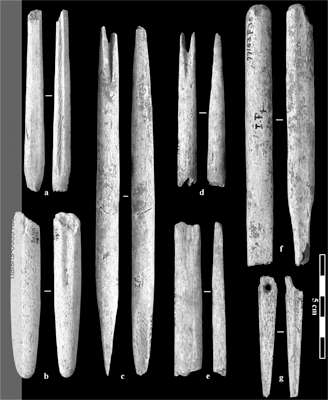
Whale-bone artifact types from the Isturitz Magdalenian.
a: projectile point mesial fragment (layer SI/Eω);
b: proximal fragment of projectile point with simple, blunt base (layer SI/Eω);
c: foreshaft (layer I/F1);
d: foreshaft distal fragment (layer I/F1);
e: half-round rod fragment (layer II/E);
f: wedge (layer I/F1);
g: mesial fragment of projectile point recycled as pendant (layer II/E).
Photo: Pétillon (2008)

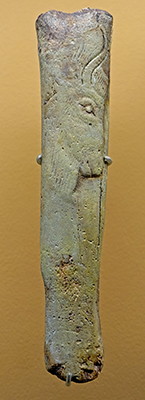
Magdelanian
Pierced baton, a spear straightener, carved with the image of a bison, from Isturitz. The spear straightener has broken, as often happens, but the curve of the bottom of the hole can still be seen at the top of the baton.
Photo (left): Don Hitchcock 2015
Photo (right): Don Hitchcock 2018
Source: Facsimile, Musée d'Archeologie Nationale et Domaine, St-Germain-en-Laye

Heads of bisons on spear straighteners, sculpted in reindeer antler, nearly identical, from the Grotte d'Enlène in Ariège and from the Grotte d'Isturitz in Pays Basque
Almost certainly from the same artist, this demonstrates, just like the multiple copies of propulseurs (spear throwers, atlatls) with a fawn and birds, that trade was normal in this society.
Photo: cl. © Service d'Exploitation des Sites Touristiques de l'Ariège et © Musée d'archéologie nationale
Source: http://www.creap.fr/imgsExpo/expo-module3.htm
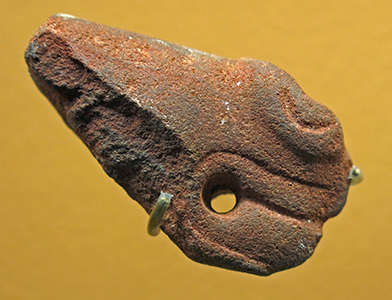
Magdelanian
Horse muzzle sculpted in sandstone.
This fragmentary piece is remarkable not only for the deft and artistic rendering of the subject, but for the perfectly cylindrical hole in the muzzle, presumably so that it could be used as a pendant.
It is interesting to speculate how this hole might have been made. A flint perçoir could not have made such a hole - it may have been made by a rod or cylinder of wood or bone twirled in the thong of a small bow, gradually grinding through the piece.
Photo: Don Hitchcock 2014
Source: Original, Musée d'Archeologie Nationale et Domaine, St-Germain-en-Laye
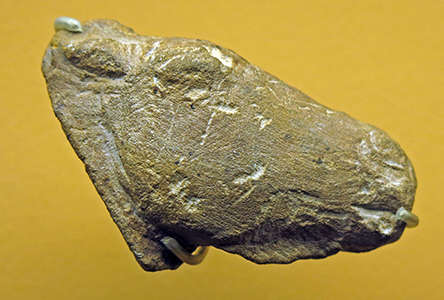
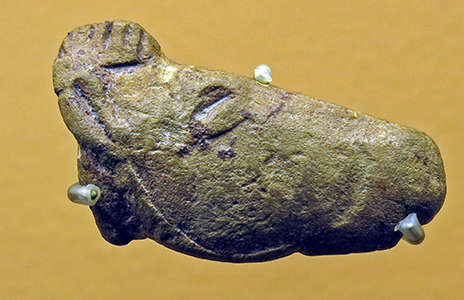
Magdelanian
Horse heads sculpted in sandstone.
Photo: Don Hitchcock 2014
Source: Original, Musée d'Archeologie Nationale et Domaine, St-Germain-en-Laye

Magdelanian
Bear head sculpted in sandstone.
Photo: Don Hitchcock 2014
Source: Original, Musée d'Archeologie Nationale et Domaine, St-Germain-en-Laye

Magdelanian
Horse head sculpted in sandstone.
Photo: Don Hitchcock 2014
Source: Original, Musée d'Archeologie Nationale et Domaine, St-Germain-en-Laye

Magdelanian
Part of a propulseur or spear thrower, carved in the image of a fawn, a doe, or a young ibex or chamois, from Isturitz.
There were many pieces in exactly this style fashioned at one period. Complete examples, as shown below, have the fawn looking over its shoulder at a turd coming out of its rear end, with two parrots on the turd, with their tails forming the hook of the spear thrower.
Photo: Don Hitchcock 2014
Source: Facsimile, Musée d'Archeologie Nationale et Domaine, St-Germain-en-Laye

Spearthrower made of antler showing a young ibex (or possibly a chamois) with an emerging turd on which two birds are perched, found around 1940 in the cave of Le Mas d'Azil, Ariege.
This was one of the first examples of mass produced art. Fragments of up to ten examples of this design have been found, which means that scores or hundreds must have been manufactured originally. The joke must have been very popular amongst the people of the time!
The ibex figure alone is about 7 cm long, and dates to about 16 000 BP. The entire propulseur is 29.5 cm in length. The engraved line along the body of the animal possibly represents a change in the colour of the coat.
Although most authorities give the interpretation of a turd with birds above, Bandi (1988) proposes that the 'sausage' coming out of the back of the ibex/chamois is the sac of an infant, and the animal is giving birth. The reasons given are that animals never look back to see their own excrement, but usually do so when giving birth. In addition, the author says that the object is too thick to be excrement, it is much more likely to be the sac of an infant.
Photo: Don Hitchcock 2008
Source: Facsimile, Musée d'Archeologie Nationale et Domaine, St-Germain-en-Laye
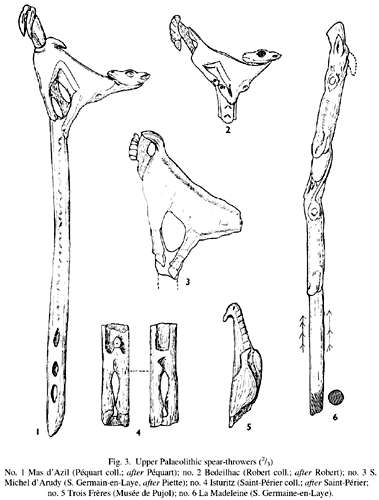
These drawings are useful to demonstrate the ubiquity and spread of the propulseur design above, at other places such as Bedeilhac and St Michel d'Arudy.
Source: Palaeolithic Spear-Throwers. Garrod, D. Proceedings of the Prehistoric Society 21, 1955.

Pendant in the form of a bear, sculpted in sandstone and pierced through the centre of the body, from Isturitz.
Views of the front and the back.
Photo: © Musée d'archéologie nationale
Source: http://www.creap.fr/imgsExpo/expo-module3.htm

Another view of the bear sculpture above.
Photo: Don Hitchcock 2014
Source: Facsimile, display, Grottes d'Isturitz et Oxocelhaya
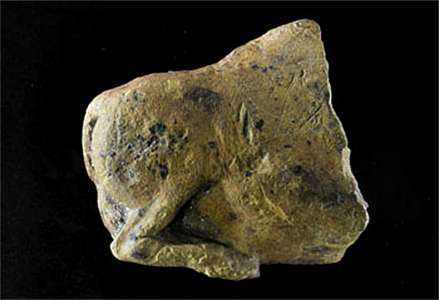
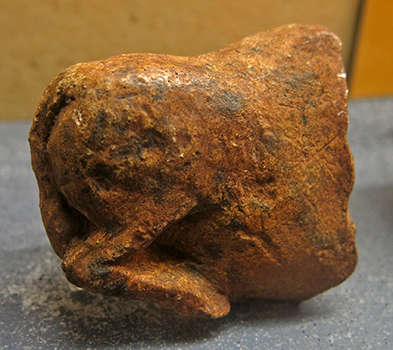
Statuette of a resting bison, sculpted in sandstone, from Isturitz.
(left)
Photo: © Musée d'archéologie nationale
Source: http://www.creap.fr/imgsExpo/expo-module3.htm
(right)
Photo: Don Hitchcock 2014
Source: Facsimile, display, Grottes d'Isturitz et Oxocelhaya

Magdelanian
9 and 10: Figure of two bisons following each other on the flat side of a piece of bone, and with two women (?) following each other on the other side. This is a very famous piece from Isturitz.
Photo: Don Hitchcock 2014
Source: Facsimile, Musée d'Archeologie Nationale et Domaine, St-Germain-en-Laye
This image of two creatures, possibly women, shows them wearing neckbands, bracelets and anklets. These creatures may be human, or figures from mythology, or even two images of an animal god of some kind. They may also represent a shaman dressed in shape-shifting clothes and mask.
The creatures are marked with barbs and other symbols, but it is not certain what they represent.
Source: "Exploring the Ice Age" by Margaret Cooper, copyright 2001, isbn 0-689-82556-0
The book says that it comes from a French Pyrenees rock shelter, but no other information is given. It comes from Isturitz, and is of Magdalenian age.
My thanks to Marion for bringing this excellent book to my attention.
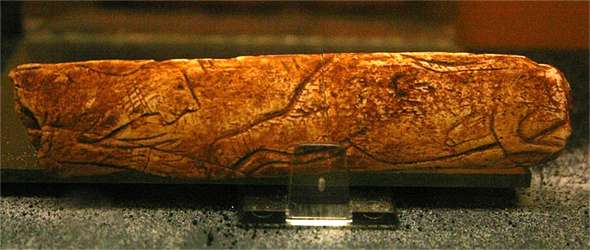
Another photo of the object above. It is 10 cm long. The barbed signs are apparently not uncommon in the art of Isturitz.
Photo: http://prehistoart.canalblog.com/
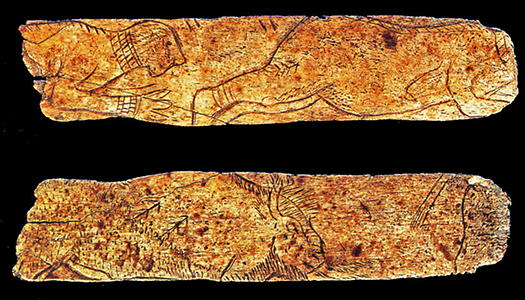
Another photo of the object above.
Photo: http://www.arretetonchar.fr/

Photo: http://polephylogenie.free.fr/GrotteIsturitz.htm
This is a drawing of the two sides of the bone. It shows clearly the barbs on both sets of images.
According to this site, JA Mauduit describes the object in 40 000 ans d'Art Moderne:
"A man lying naked, adorned with bracelets, reaches for a woman lying before him. The woman is strong and hairy, and on her thigh, an arrow with a triple row of barbs, the symbol of his conquest. The engraving on the other side is not unrelated to the previous one: it is a bison male ready to mate with a female of which there are the hindquarters and tail erect, the male also has barbed arrows on the shoulder.
Source: Figure taken from the book of Heuvelmans et Porchnev, p. 430.
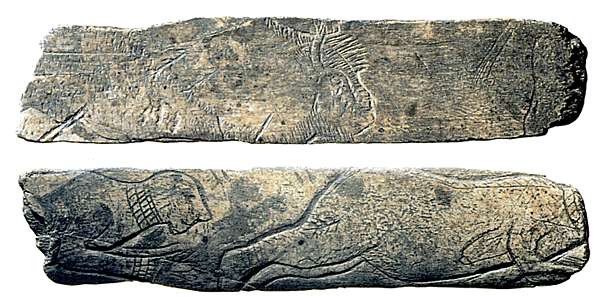
And yet another image, this one showing the reverse side, with the two bison. Note that the breast of the woman in front is lying flat on her chest, as though she is standing up.
The bison and the women seem to be following one another around the bone, and the object may show the women entering the world of bison, even becoming a bison, then returning to the female human body again. The arrows on the two sets of figures link the two images with the same signs. The women may be crawling through a birthing tunnel, and kept within the confines of the bone they are depicted on, to the world of bison.
This seems to me to be an important piece, not just art for the sake of art, and which evoked powerful magic in the world of the carver.
Photo: Bahn et al (1997)
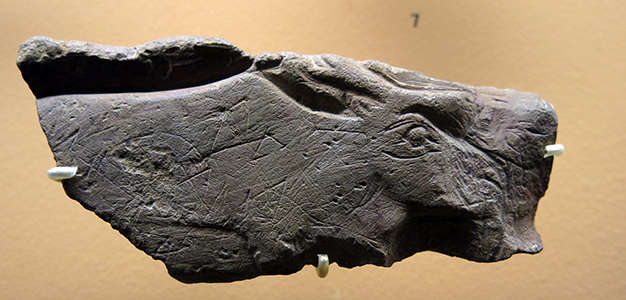
Magdelanian
11: Plaque engraved with the figure of a reindeer in bas relief. Sandstone.
Photo: Don Hitchcock 2014
Source: Original, Musée d'Archeologie Nationale et Domaine, St-Germain-en-Laye
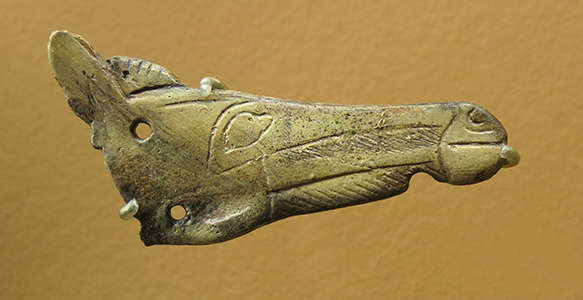
Magdelanian
Horse head cut out of a hyoid bone.
Photo: Don Hitchcock 2014
Source: Facsimile, Musée d'Archeologie Nationale et Domaine, St-Germain-en-Laye
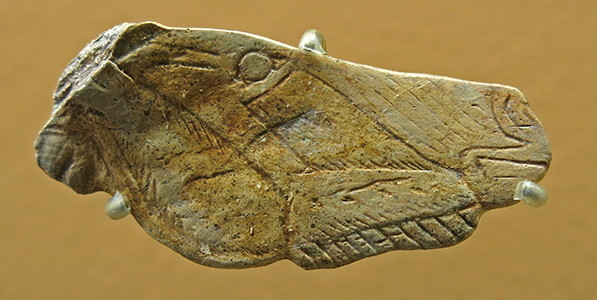
Magdelanian
Horse head cut out of a hyoid bone.
Photo: Don Hitchcock 2015
Source: Facsimile, Musée d'Archeologie Nationale et Domaine, St-Germain-en-Laye
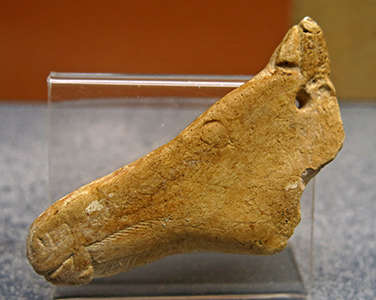
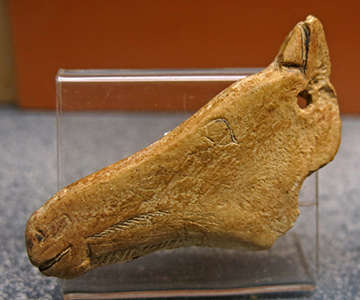
Magdelanian
Near identical horses on hyoid bones, possibly by the same artist.
Photo: Don Hitchcock 2014
Source: Facsimile, display, Grottes d'Isturitz et Oxocelhaya
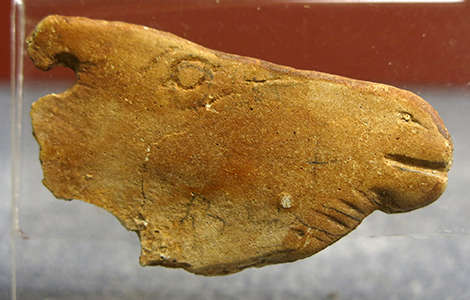

Magdelanian
Horse sculptures.
Photo: Don Hitchcock 2014
Source: Facsimile, display, Grottes d'Isturitz et Oxocelhaya

Magdelanian
Horse sculpture.
Photo: Don Hitchcock 2014
Source: Facsimile, display, Grottes d'Isturitz et Oxocelhaya
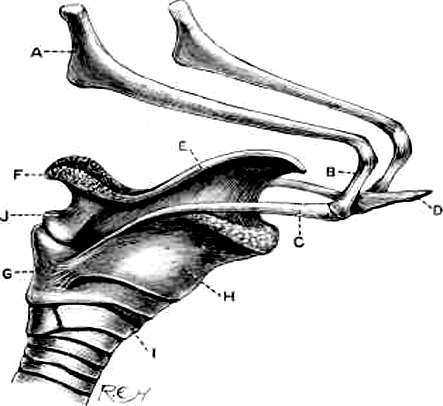
Horse hyoid bone, the long bone labelled "A" in the diagram.
Photo: http://chestofbooks.com/animals/horses/Health-Disease-Treatment-2/Inferior-Maxillary-Bone-Or-Lower-Jaw.html

This horse's head comes from the Grotte d'Enlène, near Trois Frères. It would seem that the fashion for this sort of artefact was widespread across the Pyrenees. It is very similar to the ones from Isturitz.
Photo: Tête de cheval découpée et gravée sur os d'Enlène (cl. C. Fritz/ © Service d'Exploitation des Sites Touristiques de l'Ariège)
Source: http://www.creap.fr/imgsExpo/expo-module3.htm
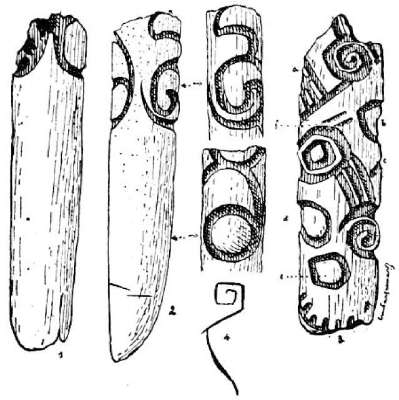
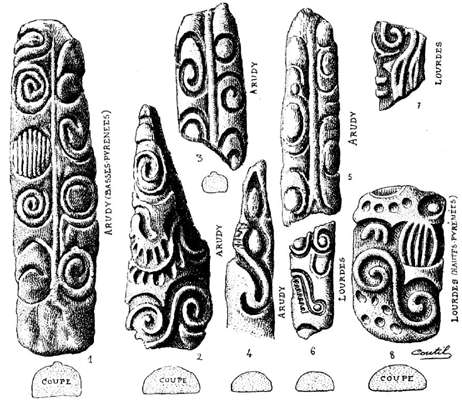
Magdelanian
(left) Spirals on baguettes demi-rondes found at Isturitz.
(right) For comparison, spirally decorated baguettes demi-rondes at Arudy in the Basses Pyrénées and at Lourdes, in the Hautes Pyrénées.
Note the cross sections.
Photo: Passemard (1920)
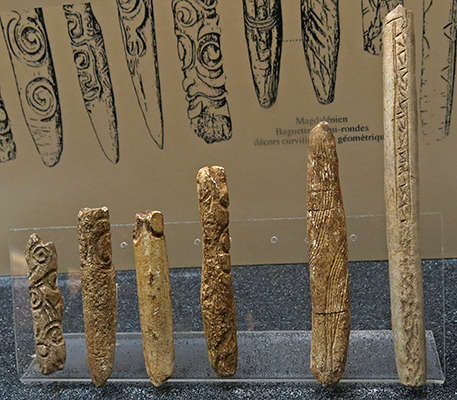
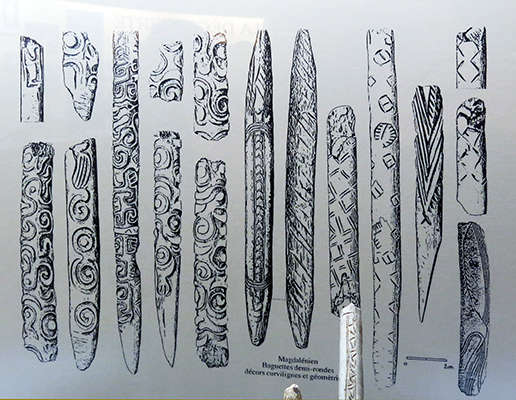
Magdelanian
Baguettes demi-rondes from Isturitz.
Photo: Don Hitchcock 2014
Source: Facsimile, display, Grottes d'Isturitz et Oxocelhaya
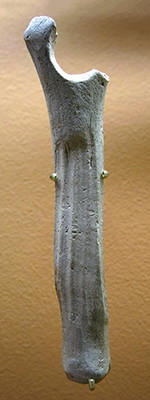
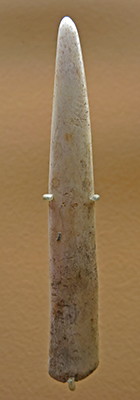
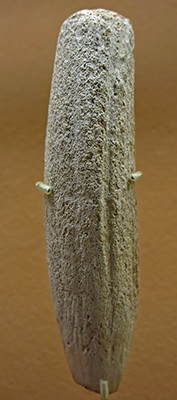
Magdelanian
Left: Baton percé with grooves.
Centre: Lissoir, or polisher, used to work hides.
Right: Wedge used to split bone and antler.
Photo: Don Hitchcock 2015
Source: Original, Musée d'Archeologie Nationale et Domaine, St-Germain-en-Laye
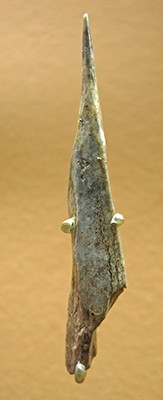


Magdelanian
(left) Poinçon, awl.
(centre) Eyed needle.
(right) Spear tip with a single bevel, grooved and engraved. This spear tip is of the Lussac-Angles type. These are from the Middle Magdalenian, and are rather short and wide to lanceolate, on a single bevel, sharp at the distal end, with a long unstriated bevel, always on the upper side, and a groove frequently on the underside.
Photo: Don Hitchcock 2015
Source: Original, Musée d'Archeologie Nationale et Domaine, St-Germain-en-Laye

Magdelanian
Needle polisher from la grotte d'Isturitz.
Dimensions: length 97 mm, width 59 mm, thickness 42 mm.
Catalog: MAN77155E1
Photo: Don Hitchcock 2018
Source: Original, Musée d'Archeologie Nationale et Domaine, St-Germain-en-Laye
Text: https://www.photo.rmn.fr
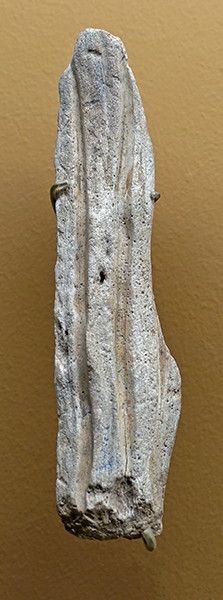
Magdelanian
Grooved reindeer antler from la grotte d'Isturitz.
Dimensions: length 161 mm, width 39 mm
Catalog: MAN83886 (sic)
Photo: Don Hitchcock 2018
Source: Original, Musée d'Archeologie Nationale et Domaine, St-Germain-en-Laye
Text: https://www.photo.rmn.fr

Magdelanian
Spear point with a single bevel from la grotte d'Isturitz.
Dimensions: length 109 mm, width 9 mm thickness 9 mm.
Catalog: MAN83886 (sic)
Photo: Don Hitchcock 2015
Source: Original, Musée d'Archeologie Nationale et Domaine, St-Germain-en-Laye
Text: https://www.photo.rmn.fr

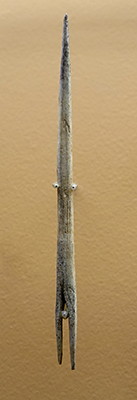
Magdelanian
(left): Spear tip with a double bevel.
(right): Spear tip with a forked base.
Photo: Don Hitchcock 2018
Source: Original, Musée d'Archeologie Nationale et Domaine, St-Germain-en-Laye

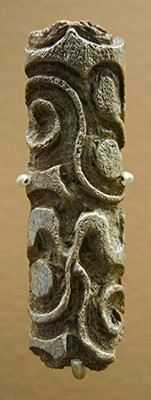
Magdelanian
(left and right): Engraved baguettes demi-rondes. These are spear tips or points formed of two half-cylindrical rods of bone or antler glued together, often with deeply incised decoration.
Photo: Don Hitchcock 2014
Source: Original, Musée d'Archeologie Nationale et Domaine, St-Germain-en-Laye
Text: Sacchi (2003)

Magdelanian
Baguettes demi-rondes engraved in spirals are characteristic of the Grotte d'Isturitz.
Photo: Don Hitchcock 2014
Source: After E. and S. de Saint-Périer, from a display at the Musée d'Archeologie Nationale et Domaine, St-Germain-en-Laye

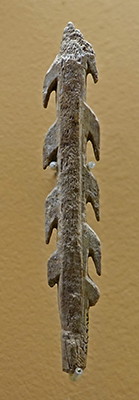
Magdelanian
(left): Harpoon with a single row of barbs.
(right): Harpoon with a double row of barbs.
Although we now think of these as being strictly for spearing fish, they may well have been used to hunt other game.
Photo: Don Hitchcock 2018
Source: Original, Musée d'Archeologie Nationale et Domaine, St-Germain-en-Laye


(left): Magdalenian one sided harpoon with six barbs, though there may originally have been more, from la grotte d'Isturitz, in reindeer antler.
Dimensions: 173 mm long, 13 mm wide, 8 mm thick.
( Of particular interest in this piece is that the barbs are not exaggeratedly wide like most such harpoons. This would have allowed much less force to have been used to get good penetration of the prey, although it would have been less secure - Don )
Catalog: MAN75295.I
(right): Magdalenian spear point with a simple pointed base, from la grotte d'Isturitz.
Dimensions: length 71 mm, width 7 mm, thickness 5 mm.
Catalog: MAN83886
Photo: Don Hitchcock 2018
Source: Original, Musée d'Archeologie Nationale et Domaine, St-Germain-en-Laye
Text: https://www.photo.rmn.fr
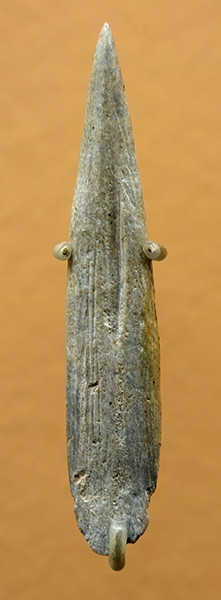


(left): Magdalenian spear point in reindeer antler, of the Lussac-Angles type, from la grotte d'Isturitz.
Dimensions: length 62 mm, width 11 mm, thickness 8 mm.
Catalog: MAN83886
(centre): Magdalenian spear point in reindeer antler, of the Lussac-Angles type, from la grotte d'Isturitz.
( note the single bevel on this point, scored with crosshatching to give purchase for the birchbark glue used to attach the spear point to the shaft of the spear - Don )
Dimensions: length ? mm, width 9 mm, thickness 8 mm.
Catalog: MAN83886
(right): Magdalenian spear point with a single bevel in reindeer antler from la grotte d'Isturitz.
Dimensions: length 114 mm, width 12 mm, thickness 11 mm.
Catalog: MAN83886
( note that the catalog numbers are all the same for these items - Don )
Photo: Don Hitchcock 2015
Source: Original, Musée d'Archeologie Nationale et Domaine, St-Germain-en-Laye
Text: https://www.photo.rmn.fr
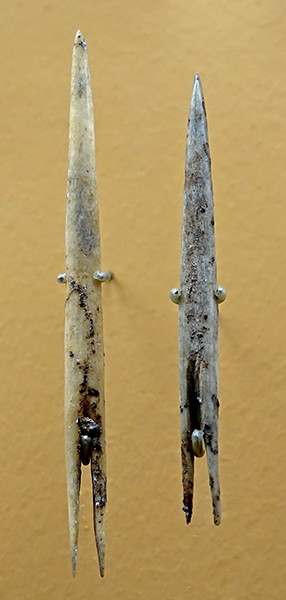
(left) Magdalenian spear point with a forked base in reindeer antler from la grotte d'Isturitz.
Dimensions: length 108 mm, width 8 mm, thickness 7 mm.
Catalog: MAN86495
(right) Magdalenian spear point with a forked base in reindeer antler from la grotte d'Isturitz.
Dimensions: length 87 mm, width 8 mm, thickness 6 mm.
Catalog: MAN77163G(?)45
Photo: Don Hitchcock 2018
Source: Original, Musée d'Archeologie Nationale et Domaine, St-Germain-en-Laye
Text: https://www.photo.rmn.fr

Magdalenian baguette demi-ronde in reindeer antler from la grotte d'Isturitz.
Dimensions: length 147 mm, width 13 mm, thickness 6 mm.
Catalog: MAN77159B6
( Baguettes demi-ronde were used in pairs as part of a spear point, with a flint point clamped at the ends between the two half round pieces of reindeer antler, secured with sinew and black birch bark glue. They were often highly decorated - Don )
Photo: Don Hitchcock 2015
Source: Original, Musée d'Archeologie Nationale et Domaine, St-Germain-en-Laye
Text: https://www.photo.rmn.fr
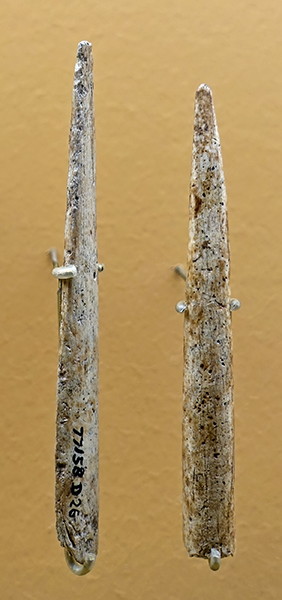
(left): Magdalenian baguette demi-ronde in reindeer antler from la grotte d'Isturitz.
No dimensions given in the catalog.
Catalog: MAN77185D26 ( note that the catalog number written on the item is 77158D26 - Don )
(right): Magdalenian baguette demi-ronde in reindeer antler from la grotte d'Isturitz.
Dimensions: length 95 mm, width 11 mm, thickness 5 mm.
Catalog: MAN83885
Photo: Don Hitchcock 2018
Source: Original, Musée d'Archeologie Nationale et Domaine, St-Germain-en-Laye
Text: https://www.photo.rmn.fr
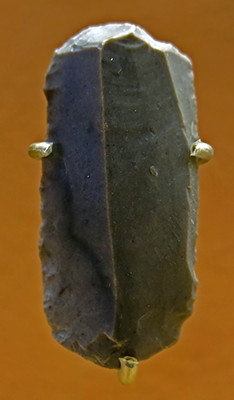

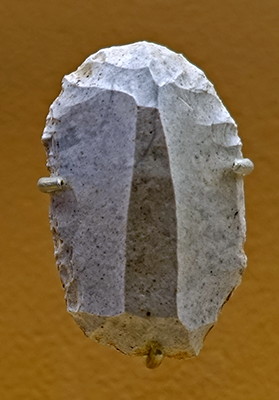
Magdelanian
Double grattoirs, double ended scrapers on a blade.
Grattoirs are 'end' scrapers, Racloirs are 'side' scrapers, in general.
Photo: Don Hitchcock 2015, 2014, 2018
Source: Original, Musée d'Archeologie Nationale et Domaine, St-Germain-en-Laye


Magdelanian
A combination of a grattoir and a burin on the same tool.
Photo: Don Hitchcock 2018, 2014
Source: Original, Musée d'Archeologie Nationale et Domaine, St-Germain-en-Laye

Magdelanian
Burin perçoir, burin drill.
Photo: Don Hitchcock 2015
Source: Original, Musée d'Archeologie Nationale et Domaine, St-Germain-en-Laye
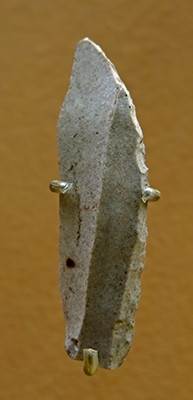
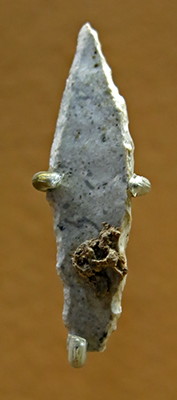
Magdelanian
(left): Point.
(right): Shouldered Point.
Photo: Don Hitchcock 2015
Source: Original, Musée d'Archeologie Nationale et Domaine, St-Germain-en-Laye
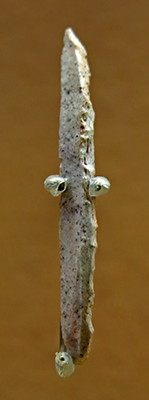
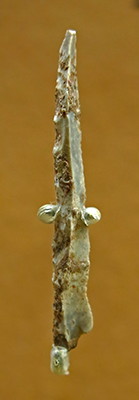
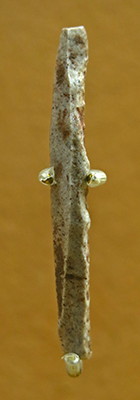
Magdelanian
Backed Blades
Photo: Don Hitchcock 2015
Source: Original, Musée d'Archeologie Nationale et Domaine, St-Germain-en-Laye

Fragment of a blade with a fossil sea urchin, flint from Tercis, south western France.
(note that this fossil appears to be of one of the irregular echinoids, which makes sense when you consider the method of formation of flint on the sea floor. Irregular echinoids appeared for the first time in the Jurassic and rapidly specialised for deposit feeding, possibly triggered by ever rising levels of ocean productivity - Don )
Irregular echinoids lead a very different lifestyle from that of the regulars. They burrow along the sea floor and bulk-feed on the sediment to extract nutrients. For this reason the radial symmetry inherited from the regulars has been modified; the mouth moving to the front of the animal to collect food and the anus moving to the rear to leave waste behind. Hence their form is now irregular, with only one plane of symmetry.
The spines have lost their defensive role and have become reduced and hair-like. They now help to form the burrow, move the echinoid through the sediment, gather food and generate circulatory currents within the burrow. Many irregulars have lost their jaws as they are unnecessary to their mode of life. The tube feet are modified into flanges for respiration and gathering food, and the ambulacra are often sunken to form a petal shape on top of the echinoid.
Isturitz, Centre d'étude et de Recherche d'Hasparren, Magdalenian
Photo: Don Hitchcock 2014
Source and text: La Maison de la Dame, Brassempouy Museum
Additional text: http://www.discoveringfossils.co.uk/echinoids.htm, http://www.nhm.ac.uk/our-science/data/echinoid-directory/intro/evolution.html
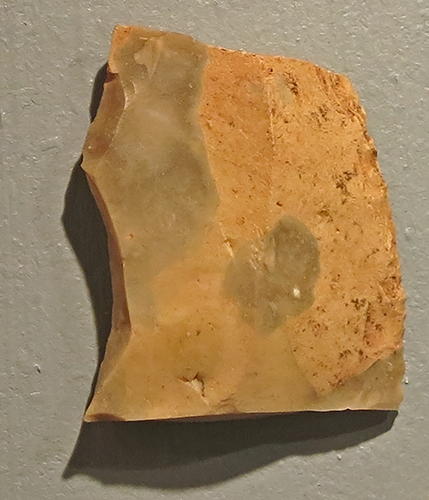
Fragment of a retouched blade.
Anticlinal flint from Audignon.
Photo: Don Hitchcock 2014
Isturitz, Centre d'étude et de Recherche d'Hasparren, Magdalenian
Source and text: La Maison de la Dame, Brassempouy Museum
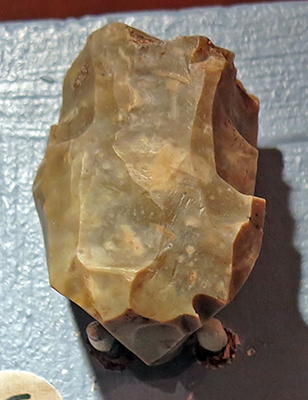
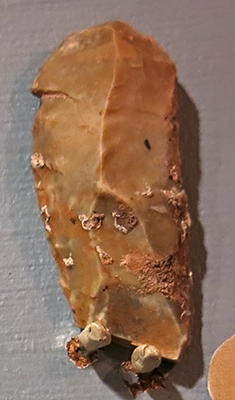
(left) Nucleus or core from which blades have been struck off.
(right) Grattoir (scraper) on a retouched blade.
Both items are of flint from the anticline of Audignon.
Photo: Don Hitchcock 2014
Isturitz, Centre d'étude et de Recherche d'Hasparren, Magdalenian
Source and text: La Maison de la Dame, Brassempouy Museum


(left) Grattoir.
Flint from the anticline of Audignon.
(right) Fragment of a blade.
Flint from the anticline of Audignon or Gaujacq
Photo: Don Hitchcock 2014
Isturitz, Centre d'étude et de Recherche d'Hasparren, Magdalenian
Source and text: La Maison de la Dame, Brassempouy Museum

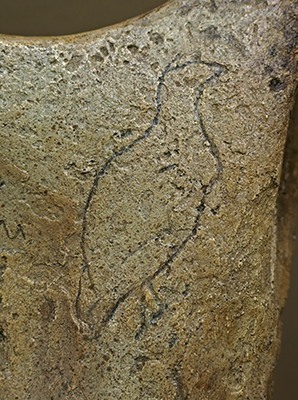
Magdelanian
Bird engraved on bone.
Photo: Don Hitchcock 2015
Source: Facsimile, Musée d'Archeologie Nationale et Domaine, St-Germain-en-Laye
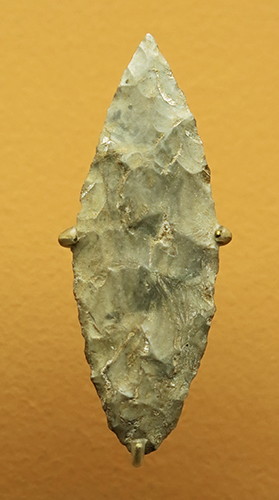
Solutrean
(left and above) Laurel Leaf points from Isturitz.
Photo: Don Hitchcock 2015
Source: Original, Musée d'Archeologie Nationale et Domaine, St-Germain-en-Laye
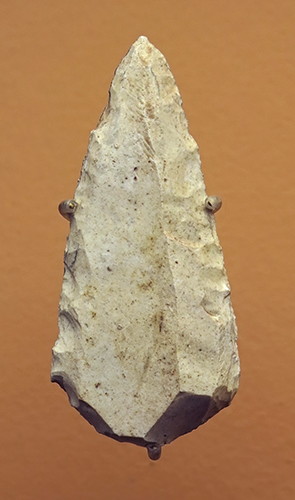
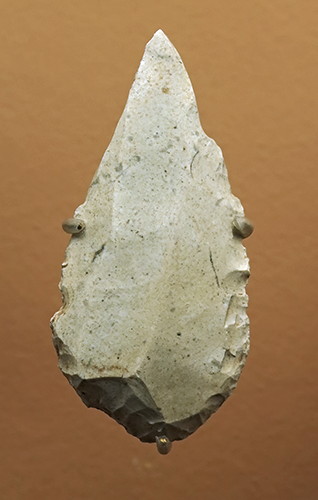
Solutrean
(left): Grattoir of the convergent type, with two scraping edges meeting to form an isosceles triangle.
(right): grattoir-burin.
Photo: Don Hitchcock 2015
Source: Original, Musée d'Archeologie Nationale et Domaine, St-Germain-en-Laye
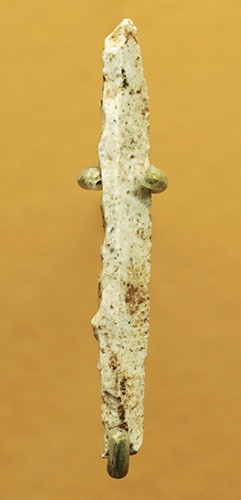
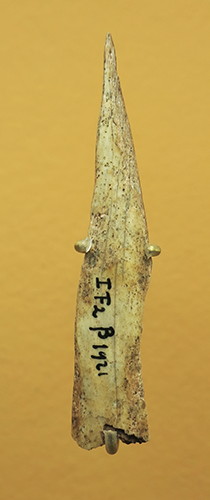

Solutrean
(left) Backed blade.
(centre) Poinçon or awl.
(right) Pointe de sagaie à base raccourcie, or spear point with a shortened base.
Photo: Don Hitchcock 2015
Source: Original, Musée d'Archeologie Nationale et Domaine, St-Germain-en-Laye
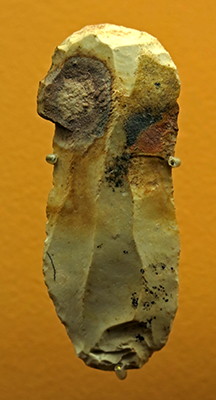
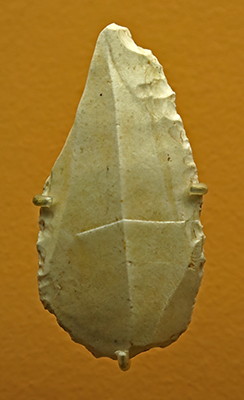
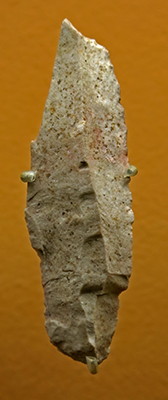
Solutrean
(left): Grattoir
(centre): Grattoir-Burin
(right): Burin
Photo: Don Hitchcock 2015
Source: Original, Musée d'Archeologie Nationale et Domaine, St-Germain-en-Laye


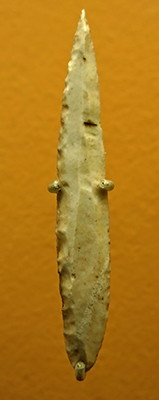
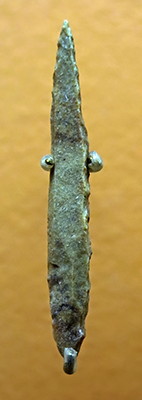
Solutrean
(far left): Noailles Burin.
(others): Gravettian Points
Photo: Don Hitchcock 2015
Source: Original, Musée d'Archeologie Nationale et Domaine, St-Germain-en-Laye
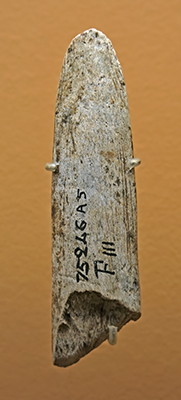
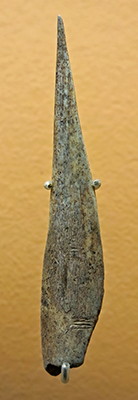
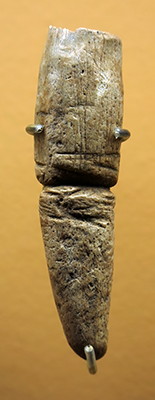
Solutrean
(left): Lissoir, burnisher, used to work hides. They typically break just where this one has broken.
(center): Poinçon, awl.
(right): Bouchon d'outre, waterskin stopper. The stopper was pushed into the opening (typically the skin of a leg of the animal) and tied at the groove to keep it watertight.
Photo: Don Hitchcock 2015
Source: Original, Musée d'Archeologie Nationale et Domaine, St-Germain-en-Laye

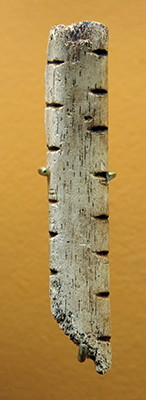
Solutrean
(left): Sagaie d'Isturitz, an Isturitz spear point with typical sub-parallel markings on it.
( in fact, this looks much more like a lissoir, made from a rib rather than a long bone. In addition, the otherwise typical sub-parallel scorings look like the lissoir was mounted on a handle, and the scorings were put there so that the birch bark glue had some purchase. Yet the general outline is that of a classic Isturitz spear point, flattened - Don )
(right): Notched bone.
Photo: Don Hitchcock 2015
Source: Original, Musée d'Archeologie Nationale et Domaine, St-Germain-en-Laye
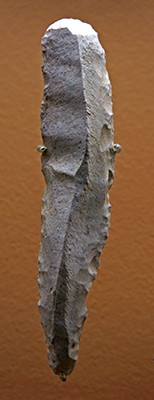
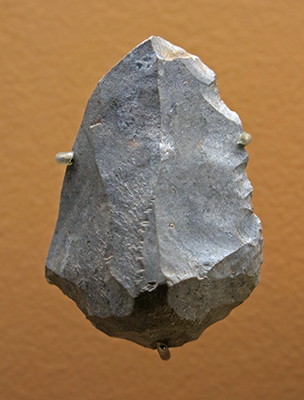
Aurignacian
(left): Aurignacian blade.
(right): Grattoir-burin.
Photo: Don Hitchcock 2015
Source: Original, Musée d'Archeologie Nationale et Domaine, St-Germain-en-Laye
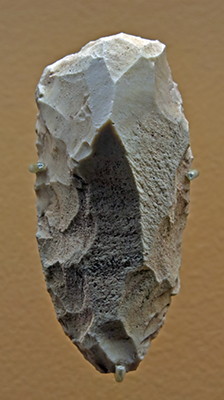
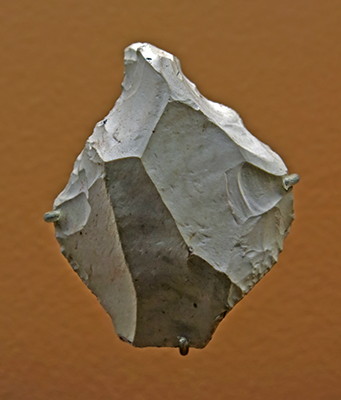
Aurignacian
Grattoirs (scrapers).
( Note that the grattoir on the right is of the grattoir-bec type, with a beaked protrusion. See Delarue et Vignard (1959) - Don )
Photo: Don Hitchcock 2015
Source: Original, Musée d'Archeologie Nationale et Domaine, St-Germain-en-Laye
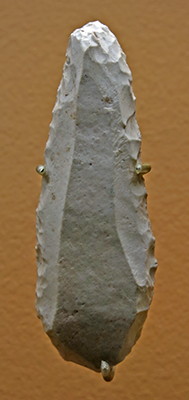
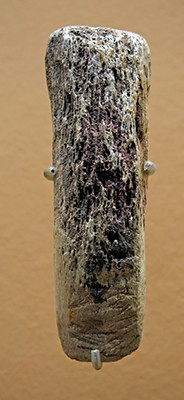
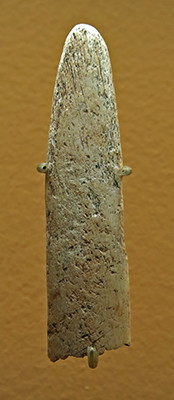
Aurignacian
(left): Grattoir (scraper).
(centre): Ciseau (literally 'chisel') or wedge.
( these were used to split bone or antler after a burin had scraped one or more grooves in the material, allowing the production of the article to be greatly speeded up rather than having to laboriously cut right through the material - Don )
(right): Lissoir or polisher.
( After defleshing using a scraper, and dehairing, accomplished by soaking in water and then urine, followed by soaking in macerated animal brains to soften the hide, these lissoirs were used to work the hides into supple leather. This was sometimes followed by treatment with other fats/oils and liquids, as well as smoking, to aid the process of forming long lasting, durable, soft leather suitable for clothing, bags, and utensils of various kinds. Tanning leaving the fur on the hide was a more skilled operation - Don )
Photo: Don Hitchcock 2015
Source: Original, Musée d'Archeologie Nationale et Domaine, St-Germain-en-Laye
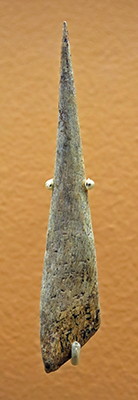


Aurignacian
(left): Poinçon, awl. ( These bone points were used to make holes in leather so that the previously cut and shaped hides could be joined together to form durable and well tailored clothing by sewing - Don )
(centre and right): Sagaies à base fendue, spear points with split bases.
Photo: Don Hitchcock 2015
Source: Original, Musée d'Archeologie Nationale et Domaine, St-Germain-en-Laye
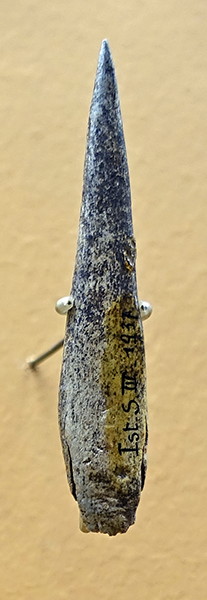
Aurignacian
Sagaie à base fendue, spear point with a split base from Isturitz.
Dimensions: 72 mm long, 13 mm wide, 5 mm thick.
Catalog: MAN83894
Photo: Don Hitchcock 2018
Source: Original, Musée d'Archeologie Nationale et Domaine, St-Germain-en-Laye
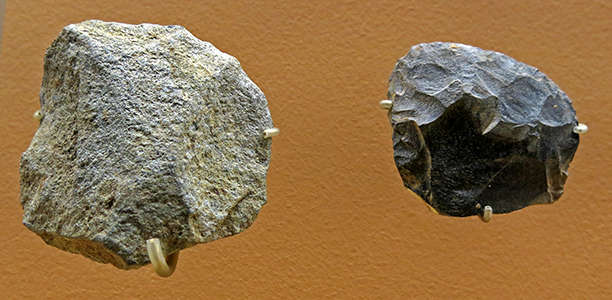
Mousterian
(left): Sandstone racloir.
(right): Flint Racloir.
Photo: Don Hitchcock 2014
Source: Original, Musée d'Archeologie Nationale et Domaine, St-Germain-en-Laye
Mousterian
(left): Racloir, scraper. ( Racloir of the convergent type, with the two scraping edges meeting to form an isosceles triangle - Don )
(centre and right): Mousterian point.
Photo: Don Hitchcock 2018
Source: Original, Musée d'Archeologie Nationale et Domaine, St-Germain-en-Laye
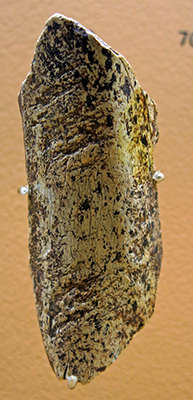
Moustérien
76: Retoucher.
Photo: Don Hitchcock 2014
Source: Original, Musée d'Archeologie Nationale et Domaine, St-Germain-en-Laye
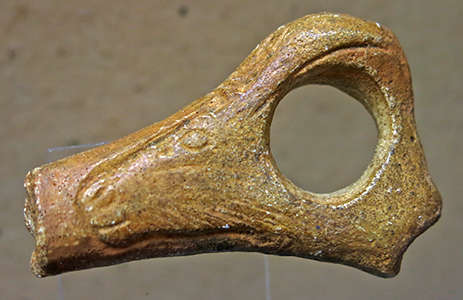
Unusually, this spear straightener has broken not at the hole, where most stress is concentrated, but at the shaft.
The ibex head carved on it flows effortlessly around the piercing.
Photo: Don Hitchcock 2014
Source: Facsimile, display, Grottes d'Isturitz et Oxocelhaya
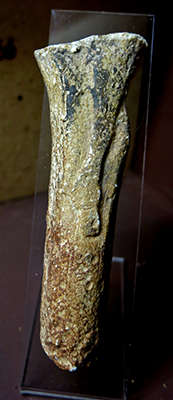
Animal leg carved on what may be a reindeer antler
Photo: Don Hitchcock 2014
Source: Facsimile, display, Grottes d'Isturitz et Oxocelhaya
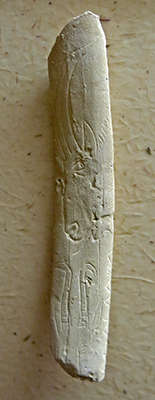
Head of ibex from the side (top) and from the front (bottom).
This facsimile has not been coloured as is normal in natural hues, which curiously makes the engravings easier to see.
Photo: Don Hitchcock 2014
Source: Facsimile, display, Grottes d'Isturitz et Oxocelhaya
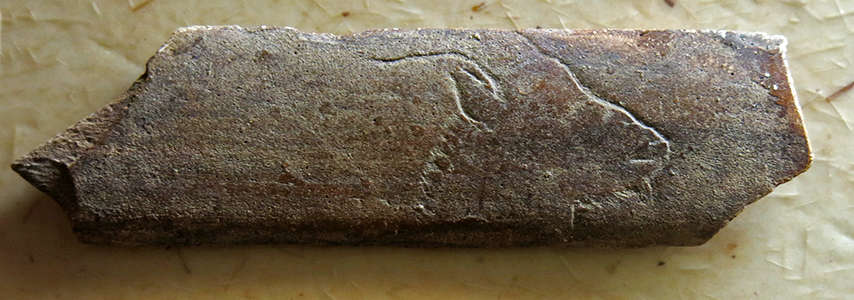
This is a superbly realised sketch of a chamois head.
Photo: Don Hitchcock 2014
Source: Facsimile, display, Grottes d'Isturitz et Oxocelhaya
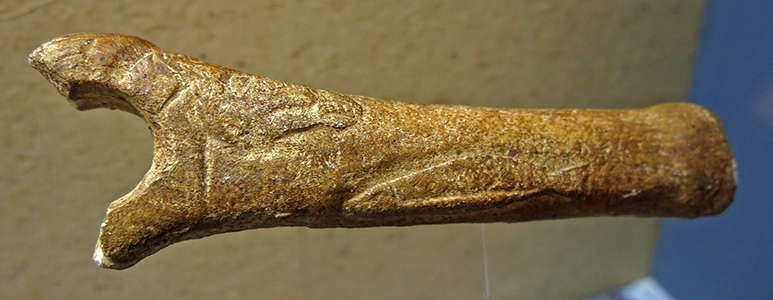
A spear straightener with an ibex head and fish carved on it, a most unusual combination.
Photo: Don Hitchcock 2014
Source: Facsimile, display, Grottes d'Isturitz et Oxocelhaya
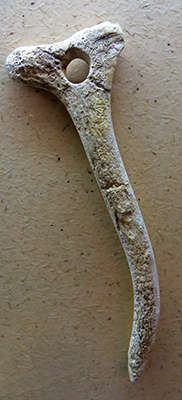
A workaday, heavily used, undecorated spear straightener.
Photo: Don Hitchcock 2014
Source: Facsimile, display, Grottes d'Isturitz et Oxocelhaya

A representation of a mammoth, or possibly a bison.
Photo: Don Hitchcock 2014
Source: Facsimile, display, Grottes d'Isturitz et Oxocelhaya
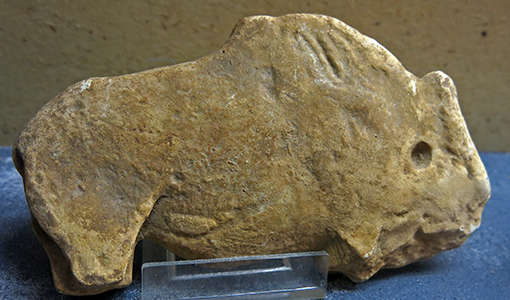
Bison sculpture.
Photo: Don Hitchcock 2014
Source: Facsimile, display, Grottes d'Isturitz et Oxocelhaya
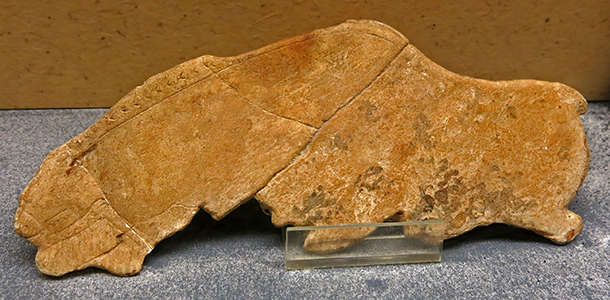
Bison sculpture. Note the beard below the jaws, and the mane on the back decorated with chevrons.
This may have been a 'found object' which suggested the shape of a bison to the artist, who made minor modifications to the shape, and engraved the rest of the likeness on the plaque.
Photo: Don Hitchcock 2014
Source: Facsimile, display, Grottes d'Isturitz et Oxocelhaya

Bas relief of a running reindeer.
Photo: Don Hitchcock 2014
Source: Facsimile, display, Grottes d'Isturitz et Oxocelhaya

Fragment of a bas relief of the legs of a deer or reindeer.
Photo: Don Hitchcock 2014
Source: Facsimile, display, Grottes d'Isturitz et Oxocelhaya

This phallus from Isturitz has very little documentation, and is mentioned only briefly in scholarly works.
Photo: Don Hitchcock 2014
Source: Display, Grottes d'Isturitz et Oxocelhaya
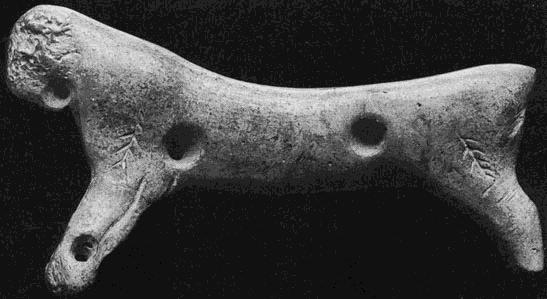
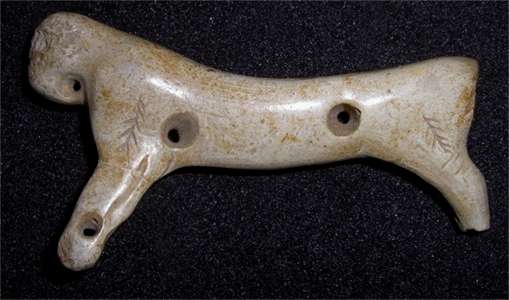
Note the "arrow" symbols carved on this beautifully polished piece.
Photo: http://www.i-s-c-a.com/show-cave/38-grottes-d-isturitz-et-oxocelhaya
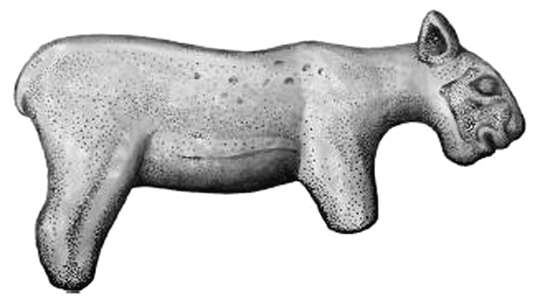
In 1896, Hour-Castagné and Lacaux-Barraqué found a 160 mm long stone figure of a big cat at Isturitz, 250 cm below ground level. Described in 1910, it appeared to be a representation of a cave lion, but the statuette was lost and its identification was forgotten. Upon seeing reproductions of the original figure, though, in 1970 the Czech paleontologist Vratislav Mazak proposed that the cat wasn’t a cave lion at all. Instead its short tail, deep face, and other features identified it as Homotherium latidens, a wide-ranging species of scimitar-toothed cat which was thought to have lived right up until the last global glaciation.
Mazak’s interpretation was interesting, but didn’t last long. Better resolution of recent geologic time showed that Homotherium went extinct before the figure was made and therefore could not have been its inspiration. By default, the figure must have been of a cave lion.
Photo: Antón et al. (2009)
Text: http://www.wired.com/wiredscience/2010/11/facing-homotherium/

A gap in time had resolved the identity of the Isturitz statue, but in 2003 a team of paleontologists led by Jelle Reumer returned to Mazak's hypothesis on the basis of new fossil material dredged up from the North Sea. In 2000 a fishing boat had trawled up the lower jaw of Homotherium, and when this jaw was subjected to radiocarbon analysis it yielded a date of about 28,000 years before present. This was the geologically youngest evidence of Homotherium latidens ever found, demonstrating that at least some of these rare predators survived until the Late Pleistocene.
Since the jaw was about the same age as the figure, Reumer and colleagues considered the new find as a confirmation of what had previously been proposed on the basis of the statuette. After several decades, the artistic record and the fossil record came into accord.
Photo: Antón et al. (2009)
Text: http://www.wired.com/wiredscience/2010/11/facing-homotherium/
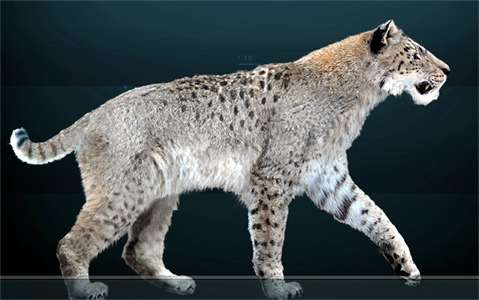
Homotherium serum, a related Scimitar Tooth cat from North America, which preyed on juvenile Columbian Mammoths (Mammuthus columbii).
Friesenhahn cave in Texas contained the remains of over 30 Homotherium serum individuals, which were discovered along with the remains of between 300 and 400 juvenile Columbian Mammoths.
Photo: Sergiodlarosa
Permission:This file is licensed under the Creative Commons Attribution-Share Alike 3.0 Unported license.

Close up of the example on display at Abri Pataud of a Sagaie d'Isturitz, or an Isturitz spear.
Photo: Don Hitchcock 2008
Source: Display at Abri Pataud Museum. This appeared to be an original.
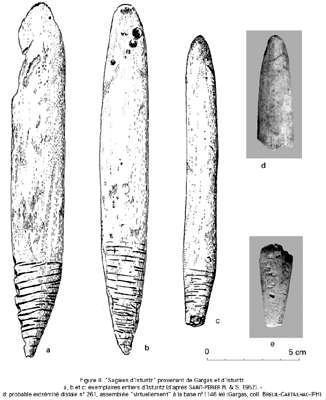
These points are known as "Sagaies d'Isturitz" or Isturitz spears. To me they look much too heavy to be points for spears, and I suspect that they are actually retouchers for taking fine flakes from flint points.
a, b and c are from Isturitz, while d is from Gargas.
Figure 8. "Sagaies d'Isturitz" provenant de Gargas et d'Isturitz.
a, b et c: exemplaires entiers d'Isturitz (d’après SAINT-PÉRIERR. & S. 1952). -
d: probable extrémité distale n°261, assemblée “virtuellement” à la base n°1146 (e) (Gargas, coll.BREUIL-CARTAILHAC-IPH).
Original Source for the sketch: Saint-Périer (1952), reprinted in: Foucher (2005)
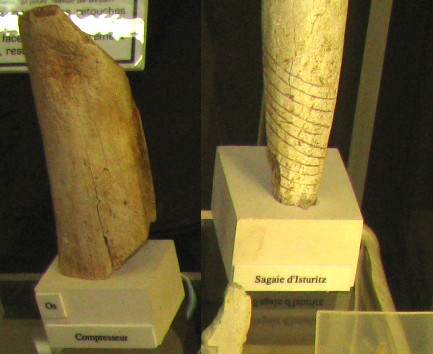
(note: These objects, "Sagaies d'Isturitz", superficially similar to spear points, seem to me to be anything but spears. They are much too big and heavy to have fitted on a dart. They could only have been used on a thrusting spear, one which was not thrown but used in close up work with an animal which had been wounded.
I have no evidence for this personal opinion, but they are much more likely so far as I can see to be retouchers, or compresseurs. This interpretation is borne out by the examples which do not have even a symbolic point, such as the ribs from Gargas shown immediately below, from apparently a similar tradition, and which Breuil & Cheynier (1958) identified as retouchers.
In addition, we may note the similarity between the Périgordien V / Noaillien Sagaie d'Isturitz shown here and the Compresseur in the previous display case for the Périgordien IV / Gravettien. They are similar in shape and volume, and both are made of bone or ivory.
I have juxtaposed two images copied from the one photograph at Abri Pataud of a Compresseur and the Sagaie d'Isturitz to show how similar they are. The compresseur has obviously been thrown away after the point was broken off - Don)
Photo: Don Hitchcock 2008
Source: Display at Abri Pataud Museum. These appeared to be originals.
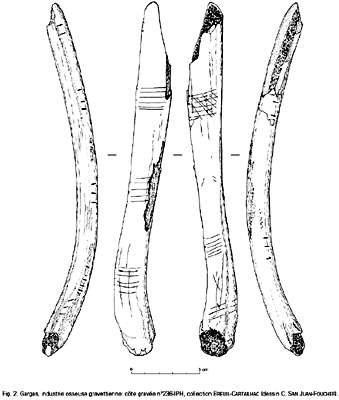
The caption reads:
Fig. 2. Gargas, industrie osseuse gravettienne: côte gravée n°236-IPH, collection BREUIL-CARTAILHAC (dessin C. SANJUAN-FOUCHER).
Gargas bone industry, a decorated rib.
It was described by Breuil & Cheynier (1958) as "a large curved piece, rounded at the end, which had been used as a retoucher. It is the left rear rib of either Aurochs or Bison"
Photo: San Juan-Foucher (2005)
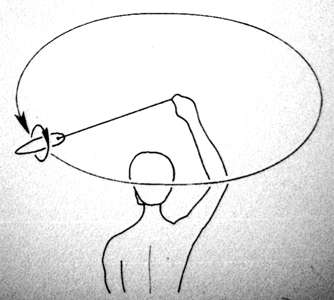
(See the image below this one for an example of a bullroarer from Lalinde, Dordogne)
Bullroarers were used as noise makers during the Paleolithic, and are swung around the head from a string, and the shape induces it to rotate in a plane vertically to the plane of rotation around the head, which produces the characteristic sound.
Photo: Kathy King 2010
Source: Display at Musée d'Archeologie Nationale et Domaine, St-Germain-en-Laye
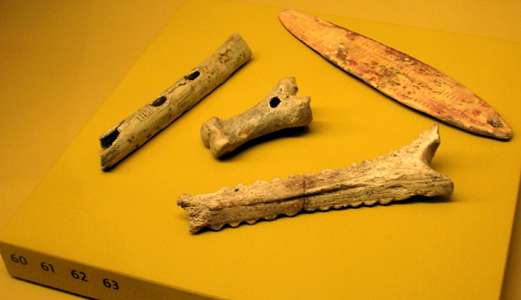

Music and dance are ephemeral art forms. However the existence of music
in the Paleolithic is attested by the discovery of several
types of instruments: flutes, whistles, bull-roarers and scrapers.
Drums probably existed in the Paleolithic, but these instruments made of wood and skin are rarely if ever preserved. However, in some caves, calcite sheets or curtains showing traces of percussion testify to the rhythmical talents of prehistoric musicians.
60: Bone flute, facsimile, from Isturitz, Atlantic Pyrenees. Aurignacian, between 40 000 and 26 000 years ago
61: Whistle in bone, original, from Laugerie-Basse, Dordogne.
62: Bullroarer or rhombus or turndun, facsimile, in reindeer antler, Lalinde, Dordogne. Note the colour, originally from ochre, and the regular straight lines and rectangles decorating it.
63: Scraper, or scraped idiophone, original, from Mas d'Azil, Ariège. This one seems to have been made from a salvaged broken spear straightener.
Scraped idiophones (an idiophone is defined as a musical instrument from which the sound comes from the natural sonorous quality of the instrument itself, not from a stretched string or hide or enclosed column of air) are rasps or notched sticks over which another stick is scraped, resulting in a series of beats.
(left)
Photo: Kathy King 2010
Source: Image and translated and adapted text from the display at Musée d'Archeologie Nationale et Domaine, St-Germain-en-Laye
(right)
Photo: Don Hitchcock 2014
Source: Musée d'Archeologie Nationale et Domaine, St-Germain-en-Laye
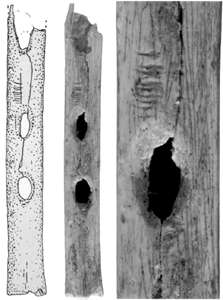
This is a photo of the original flute from the Aurignacian culture of Isturitz, which would place it between 40 000 and 26 000 years ago, shown in facsimile above.
Victor Mair (Mair, 2006) describes a collection of prehistoric flutes made of vulture wing bones:
... a very impressive collection of Upper Paleolithic flutes (or pipes) from Isturitz in southwestern France. Consisting of more than twenty separate specimens, the Isturitz flutes range widely in date from the Aurignacian to the Magdalenian (between ca. 20 000 and 35 000 years ago).
Two of the most complete pipes are from the Gravettian levels of the cave, ca. 25 000 years ago. They are extremely well made of vulture ulnae, bear finely etched identifying or notational marks, and display evidence of having been extensively used.
The flute above is artifact 77142(a) [DB 4.1] from Buisson (1990). The close-up image of the finger hole on the right shows a set of marks.

Flute from Isturitz
The brochure from the official cave site, at http://www.grottes-isturitz.com/grottes-isturitz/calendrier_gb.htm, says that it is 31 000 years old.
Note that this image has been flipped horizontally to agree with the facsimile and photos above.
Photo: From the Owner, via Google Earth
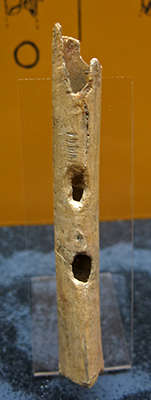
Another view of the flute above.
Photo: Don Hitchcock 2014
Source: Facsimile, display, Grottes d'Isturitz et Oxocelhaya
Some observations from D'Errico et al (2003):
From the outset we were struck by the pipe’s sophistication. Although archaeologists have sometimes been tempted to classify these things as "simple," even "primitive" instruments, close inspection revealed some intriguing musical choices and functional asymmetries. Bearing in mind how very ancient they are, with a date-range currently estimated, for most of them, at between ca. 20 000 and 35 000 years, these seemed remarkably advanced, and clearly justified careful reevaluation.Photo and text above: http://www.flutopedia.com/dev_flutes_euroasia.htm

(a, b, e, f) Photo and tracing of the two most complete pipes from the
Gravettian levels of Isturitz Cave.
Grey areas around the finger holes and at the
rear of the pipe indicate concentrations of polish interpreted as use wear;
(c) sketch identifying sets of marks made by different tools;
(d) close-up view of sets 1–3.
Text above: D'Errico et al (2003)
These two Isturitz bone flutes are attributed to the Gravettian culture, which would place them between 28 000 and 22 000 years ago.
The flute above is artifact 83888(a)/75252-A3 [DB 2] from Buisson (1990) and the flute below is artifact 86757(a) [DB 5.1] from the same reference.
The gray shading around the finger holes shown on the drawings at the right indicate concentrations of polish that are interpreted as wear from playing.
Photo : D'Errico et al (2003)
Text: http://www.flutopedia.com/dev_flutes_euroasia.htm

Complete flute, a compilation of two photographs from the first flute in the photo above this one.
There are two dates and other information marked on this flute: 1st . III . 1939 and I . F3 ch 1914
The flute above is artifact 83888(a)/75252-A3 [DB 2] from Buisson (1990)
Photo: Two original photographs from D'Errico (2003),
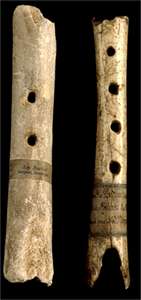
The Dordogne Bone Flutes
The P&EE Christy Collection of the British Museum has two bone flutes of uncertain age, but are "about 32 000 years old". They are from rock shelters at La Roque and Les Roches, Dordogne, France.
the Les Roches flute has two holes (left), and the La Roque flute (right) has "five holes on the front and two on the back". Both flutes are 124mm (4.88 inches) long.
Photo and text: http://www.flutopedia.com/dev_flutes_euroasia.htm

The Isturitz Baton
Engraved baton made of antler, from Isturitz, France, 25 000 to 20 000 BC. The markings represent a five-month and a four-month lunar calendar.
Photo: http://www.tacomacc.edu/home/jkellermeier/papers/menses/menses.htm

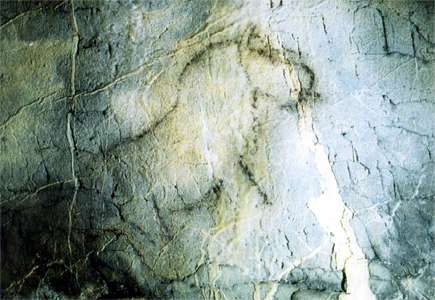
Horse apparently engraved with a finger on the clay which often covers the walls and ceilings of caves, and a painted horse.
Photo: http://www.capcampus.com/parcs-d-attractions-1389/grottes-et-gouffres/sites/grottes-d-isturitz-et-oxocelhaya/attractions
Dating of Isturitz artefacts
Only cutmarked bones were selected, and a total of 31 targets were made, giving a weighted average of 37,180±420 BP for this assemblage and providing a terminus ante quem (latest possible date) for the ornaments, decorated artefact and amber pendants beneath it. Szmidt et al. (2010)
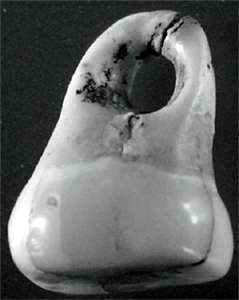
Grotte d'Isturitz, level 4a (Early Aurignacian, or Aurignacien Typique). Human Lower left M2 or M3 perforated by back-and-forth rotation. The hole, created by a rather obtuse tool point, is heavily 'worn'.
Photo and text: White (2007)
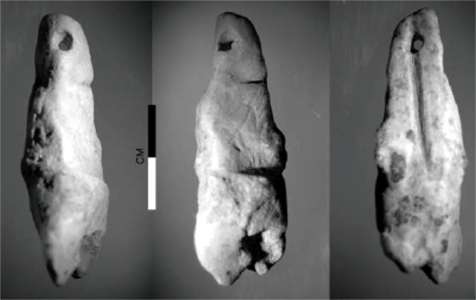
Calcite pendant from the Archaic Aurignacian level 4d1 at Isturitz. Level 4d is associated with two dates: 34,630±560 BP and 36,550±610 BP
Photo and text: White (2007)
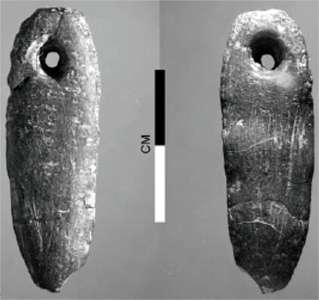
Amber pendant from the Archaic Aurignacian level 4c6 at Isturitz.
Level 4c, immediately overlying 4d and with many of the same archaic characteristics of the level 4d assemblage, remains undated for the moment. Its base has yielded the oldest known evidence evidence for amber jewellery in the world in the form of amber pendants (as shown here), production debris and raw chunks of amber. The amber pendant was almost certainly made from amber obtained from Cretaceous sources in the Pyrenean forelands (Beck et al. 1987)
Photo and text: White (2007)
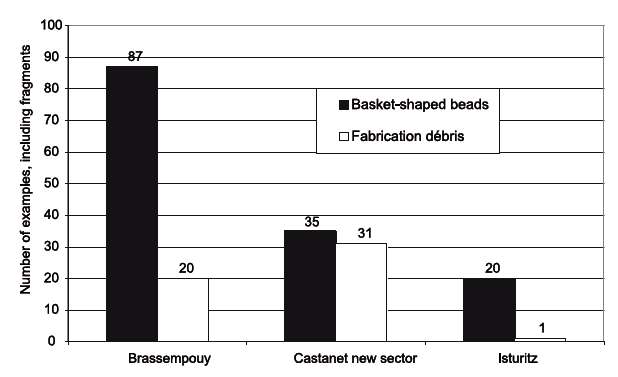
Ratios of basket-shaped beads to production débris and unfinished beads from modern excavations at the Grotte des Hyènes, Brassempouy, Abri Castanet and the Grotte d'Isturitz.
Abri Castanet was a place of intense bead production, but in the small area recently excavated at Isturitz, evidence for ornament production is virtually absent, with one exception: strong traces of the working of amber ornaments on site, a phenomenon restricted in time to levels 4b and 4c.
Photo and text: White (2007)
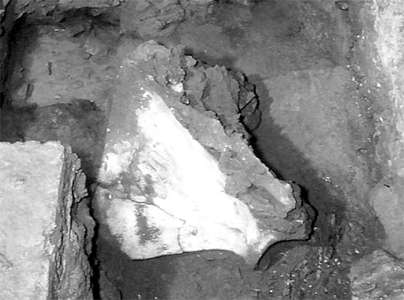
Young mammoth scapula recovered from Sondage 7 in the Salle d'Isturitz.
(Presumably the young mammoth was hunted and butchered in the field, and only the choicest cuts were taken back to the cave. Mammoth meat is rich, and the fat, hide, bones and ivory are all very useful - Don)
Photo: Normand (2005)
Fouilles à Isturitz (Basses-Pyrénées)
Digs at Isturitz
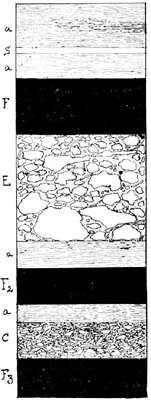
Coupe or cross section of the dig at Isturitz.
During excavations July-September 1913 in
Isturitz cave, Passemard (1913) met five successive very distinct archeological layers: F1, E, F2, G, F3.
Successively, starting with the surface, the layers yielded:
F1 - Round harpoons, with hooks on both sides (doubles) or on just one side (singles) , forked spearheads of reindeer antler (specific to this layer), double bevel points; spear straighteners and some beautiful needles, as well as various tools, punches, spatulas, etc. No works of art.
The lithic industry is represented by beautiful blades, many
burins, scrapers, an abundant microlithic industry, some of which had blunted backs.
Fauna - reindeer, very abundant, horses abundant, Deer and Bovidae fairly abundant, and others.
E - In the top part, engravings in stone and on bone. Double bevelled points in reindeer antler continued in this bed, up to two thirds down.
This upper part also yielded some beautifully engraved baguettes demi-rondes, some spear straighteners, some needles and some punches. The middle part of the E layer gave some bas-reliefs on reindeer antler and on stone, and the lower part some beautiful engravings on stone and on reindeer antler. Worked ivory was rare, but was however represented.
The typical features of this lower layer are the "bec de flûte", or dihedral burin, which replaces the other types; Solutrean laurel-leaf and willow leaf points, of elongated shape.
The stone industry provided scrapers, chisels, blades retouched on both edges, some specimens of small blades with a blunted back, scrapers, grattoirs-rabots (Rabots are heavy 'push-plane' scrapers made on blocks or thick flakes and abruptly retouched - Don) rare.
It should be noted, not as described so far, a bird bone, with pierced holes, having served as a musical instrument, and several fragments of amber.
Fauna - For the upper two parts, the same elements as in F, and for the lower part: horses very abundant, large Bovids abundant, reindeer less abundant than F, and a large joint of Rhinoceros ticorhinus was found in the middle part of E.
F2 - dihedral spearheads mainly of bones, no artistic pieces, but another bone of a large bird, pierced by a hole adapted for closing with the finger, thus a musical instrument; punches abundant and fine; marques de chasse, a series of tiny parallel lines on a bone artifact which might be interpreted as hunting tallies,
The lithic industry is not so beautiful; burins are more rare; there is the appearance of retouched flakes, to make scrapers. The fauna is dominated by bovids.
C furnishes some rare specimens of round or flat points in reindeer antler.
The true burin becomes very rare; it is replaced by a sort of demi-burin, reworked on one side and itself quite rare.
There are many scrapers, even of the double ended type, blades are thicker and less beautiful, large retouched flakes become common. Several beautiful big backed blades, points or other forms.
Fauna - Bovidae very numerous and very large; horses abundant; Reindeer few, but large, and other animals.
F3 - The stone industry becomes quite ugly and sparse; burins seem to disappear completely, even in the form of the demi-burin; scrapers persist, relatively abundant, but ugly and thick.
Some beautiful scrapers, pod shaped, finally appear and are finely retouched; a few specimens of backed blades.
The "sagaies" type of spearheads are replaced by large points in reindeer antler, a kind of spearhead pointed at both ends, some fragments of ivory. There is a complete absence of other forms.
In all layers, we found abundant fragments red, yellow or green oxides, with many small plates of sandstone and some retouchers. A rock crystal and many geodes, carrying in the hollow some remains of fat and having probably served as lamps, were found.
Also discovered were several bas-reliefs or very primitive sculptures on the walls, representing reindeer, horses, female deer, mammoths, etc.
Une gravure de lièvre d'Isturitz
Engraving of a hare at Isturitz
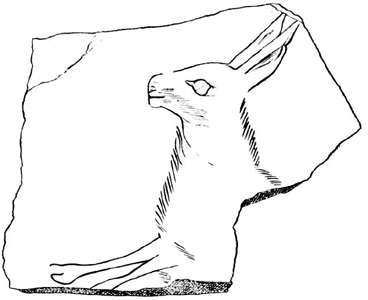
Although many Paleolithic paintings and engravings are difficult to interpret as one animal or another, with this one doubt is impossible, it is obviously a hare.
The engraving shows erect ears, nose to the wind, his eyes restless, ready to flee,
this is a worthy companion to the slow tortoise immortalised in the fables.
The details confirm the general appearance.
As always in the drawings of that time, the coat is
expressed by means of light broken hatching.
They are aligned in the direction of the hair and it lightens the form and
accentuates the rigid and solid line of the other parts.
It is a safe bet that the author of this little etching was also
a skillful hunter of hare and he had long observed that
animal in all his attitudes.
He has, indeed, perfectly understood the special character of the fur and has shown it as it really is, looking light and drawn against the grain of the neck and chest. The whiskers are also superbly indicated. Mention should also be made of the front legs which are simple but correct.
However this work is not of great style and does not attain the level of certain quaternary engravings, it looks a little sparse.
But still, it was engraved with a light touch on the burin, on a plaquette of yellowish sandstone, soft and fine grained, of which there is an abundance in the surrounding hills.
It comes from the southern gallery, rich in stone engravings, although the northern gallery produced most works engraved or carved in wood and reindeer bones.
It seems, therefore, in summary, to be the common hare of the plains. It has none of the characters of the mountain or blue Hare (Lepus variabilis), which seems exceedingly rare in deposits in this region.
Le Comte de Saint-Perier

Le Comte de Saint-Perier
Photo: http://www.corpusetampois.com/cbe-saint-perier.html
René de Saint-Perier Poilloüe was born August 18, 1877 at Biou (Loir-et-Cher), and died September 12, 1950 in his château de Morigny (Essonne). Originally a medical doctor, he turned to archeology and prehistory and began his career with digs at the Gallo-Roman site of Souzy la Briche.
He undertook pre-war excavations at Lespugue, and in 1922 discovered the famous Lespugue Venus.
Text: translated and adapted from http://www.corpusetampois.com/cbe-saint-perier.html
Quelques oeuvres d'art de la grotte d'Isturitz
Some works of art from the cave of Isturitz
The cave of Isturitz is located in the Basses-Pyrénées, with the nearest town Saint Martin d’Arberoue, near the top of a limestone hill, with the entrance to the cave facing south east. A tributary of the Adour, the Arberoue, passes under the hill, and re-emerges on the western flank of the hill. This small stream initially created the cave, then went under it and created another cave (Oxocelhaya) only discovered in 1929, 12 metres below, before finally establishing a third tunnel (Erberua), through which it now flows, 50 metres below.
The cave has two entrances today, the one in the commune of Isturitz is atop a steep slope of thirty metres, which plunges into the interior of the cave, forming a vestibule like a sinkhole, to a vast hall, 110 metres in length and whose ceiling is more than 15 metres above the floor.
Towards the middle of this room there opens on the left a narrow passage that leads to a second room, with a length roughly equal to the first, but the ceiling has fallen, but with several lateral galleries. At its end is another entrance, which was created artificially in 1912, but which existed in the Aurignacian, as is evidenced by the layers of the cave, but was closed by landslides, probably at the beginning of the Magdalenian period. The boundary between the two communes of Isturitz and Saint-Martin d'Arberoue passes through the first large room, named for this reason the Salle Isturitz, while the other is called Saint Martin.
The cave may have been the object of a cult in the Gallo-Roman period, because some large bronze objects have been recovered from the superficial levels, from the Haut-Empire, which seem to have been thrown in from the outside in the manner of an offering.
By 1890, less unselfish visitors came. Two residents of the area proposed, in effect, to exploit as fertiliser the clays and limestone which made up the cave.
The hill belonged to two landowners whose property boundaries coincided with the boundaries of the two municipalities of Isturitz and Saint-Martin. A system of winches was established at the entry to Isturitz to allow ore wagons ("bogies") to be pulled up the slope outside the cave, and mining began.
However ill-informed the merchants of fertiliser were in prehistoric matters, the unforeseen discoveries of the workers caused them some surprise.
They talked together, and we do not know by what route, but Edouard Piette was informed.
He did not come to Isturitz himself, but he understood the importance of the finds, and sent a letter to Gabriel de Mortillet.
However, the mining continued and the owner of the part of the cave located on Saint-Martin began to worry. He noticed that operators exceeded the limit of their lease and encroached on his land. He took them to court. There was a trial, an appeal, and finally a judgement to stop the extraction, but after two years the cave had been ransacked, without benefit for science.
In 1912, the exit to Saint-Martin was created, to allow access to the cave from that side of the hill. It was shortly afterwards that M. Emmanuel Passemard learned of the cave and there began his excavations. He has published the results in several books and papers. The collection he gathered is now housed at the Musée de Saint-Germain in Paris.
In 1928, we (De Saint-Périer and his wife) started our Isturitz research. We started first with the excavation of the Salle de Saint-Martin, only part of which had been explored by M. Passemard, but one gallery had been completely emptied by farmers for fertiliser.
We must confine ourselves here to describing some objects of art amongst those we found in this room and we refer to the statement quoted above for the study of stratigraphy, paleontology, plant and all works of art. We shall say only that the upper level, the only one explored by us so far, was covered with a layer of stalagmite 35 cm thick in places, and belongs to the Magdalenian without harpoons, was well defined, and rested without interposition of any sterile level on a bed of grey loam corresponding by its archeological characters to the upper Aurignacien.
Engravings are numerous in this level, sometimes on bone, sometimes on plates of schist, sometimes on sandstone. These rocks, abundant in the layer, appear to have been collected by the Magddaléniens on the side of the Arberoue valley opposite the cave. At this point, in fact, a Cretaceous formation contains schist outcrops, which cleaves easily into thin plates, and some ferruginous sandstones are found here and there among the scree slopes.
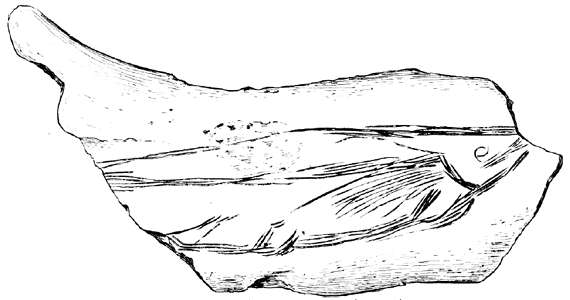
Fish engraved on bone, Isturitz. (this looks to me like a salmon - Don)
Among the engravings on bone, we show here a drawing using light strokes on a fragment of diaphysis (middle section - Don) of a large bone, which is a fish whose head and tail are incomplete because they have broken off.
Photo: De Saint-Périer (1935)
The gills are shown well, as is the eye, the mouth a wide slit, the ventral and pectoral fins are shown. The sideline is marked with a strong line. Although this is just a quick sketch, realism is sufficient for us to recognize it without hesitation as a salmonid trout or salmon.
(The sideline senses currents and movement in water. It may therefore be used to sense the presence of nearby fish, as in shoals of fish, and also may be used for swimming in water where visibility is poor and to help catch prey in these conditions. Salmon and trout belong to the same family - Don)
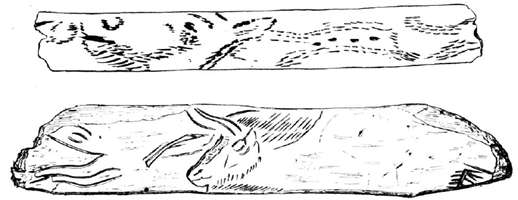
The upper etching on bone, formed of small incisions, is a bearded horse head with nostrils, eye, an ear flattened on the head, a mouth, and an indication of the jaw. Behind the head, only a few small marks represent the body, either because the place for showing it was missing from the bone, or because the artist wanted to show only the pelt of a skinned animal.
This graphic technique of small separated strokes is ordinarily used to reproduce tufts of hair or the markings on fur. Here, it was even used to represent the outline of the head.
Photo: De Saint-Périer (1935)
On a blade of bone of very similar dimensions, shown below the horse, we have a beautiful bison head, massive and powerful. The body is only lightly sketched in after a strong mane, but it carries a barbed line, which may be a more or less schematic image of a spear, although no weapon of this kind has been found in the strata of this age.
It looks like the barbed head of a harpoon, but we know that double harpoon barbs appear only much later in the Magdalenian. We have collected in this layer a prototype harpoon with barbs barely indicated, but that looks nothing like the barbed image on the bison. Thus we need to see this as either a weapon not represented in our excavations, or a symbolic representation of some kind.
When the blade of bone is turned over, one can see the incomplete head of a bovid, without mane, with horns pointing forwards. These characters suggest that this is a Bos primigenius, or Aurochs, more slender than the bison, and the ancestor of modern cattle. These are not frequent in Paleolithic representations, but this cave gave many other examples of the Aurochs.
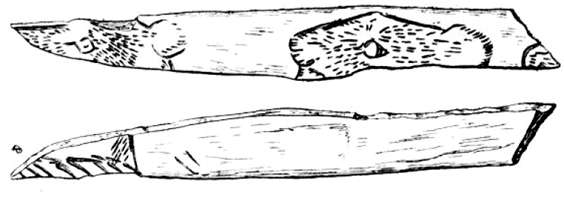
This is a species much more rarely drawn, and they represent the only known Palaeolithic representation to date, of this animal. There are two small heads, etched on a polished bone blade, the profile is convex, with round ears, wide eyes, face covered with thick fur indicated by small lines almost touching. It is not a ruminant, but a rodent or felid.
We believe that the artist wanted to show a marmot, the only animal whose convexity of profile and rounded ears, standing out against the fur of the face could be the subject of this engraving.
Photo: De Saint-Périer (1935)
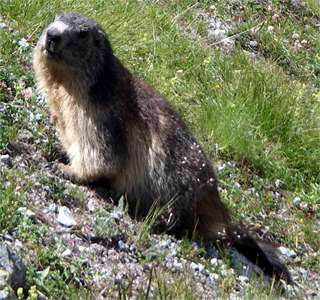
Alpine Marmot in the southern French Alps.
Photo: Taken By DevAnubis, July 2006 in the Massif des Écrins national park in the southern French Alps.
Original uploader was DevAnubis at en.wikipedia
Permission: Released under the GNU Free Documentation License. This file is licensed under the Creative Commons Attribution-Share Alike 3.0 Unported license.
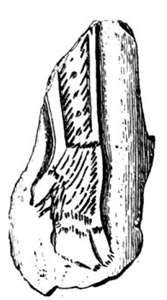
We know that a very large number of Paleolithic engravings come to us only in fragments, a result perhaps in many cases of intentional fractures, and give us only parts of the body, when they had originally represented whole animals. However, we often find drawings of heads and, more rarely, hindquarters and legs, which, by their large size or, conversely, by the smallness of the surface that has been chosen for their implementation, seem to have been designed and implemented in isolation.
Of these drawings, we show here a Bison leg which is also remarkable for the treatment of the outline, in which a light bas relief technique adds more vigour than by concentrating on minute details.
Photo: De Saint-Périer (1935)
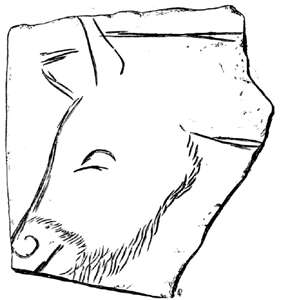
If we now turn to stone carvings, we find works that are not inferior in any way compared with engravings on bone. On a plaquette of sandstone, a profile of a horse with a fine neckline, face a little concave, with long ears, seems to belong to an Oriental type, perhaps a Tarpan, or a steppes horse. (The Przhewalsky horse is closely related to these animals - Don)
Photo: De Saint-Périer (1935)
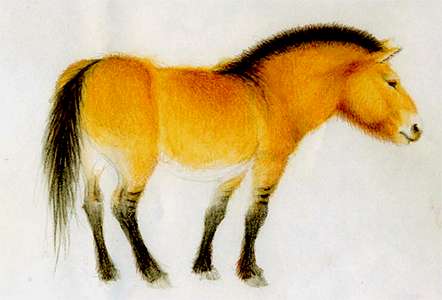
Reconstruction of the tarpan, or wild European horse, Equus ferus.
Photo: Illustration by Daniel Pickering, Carnegie Museum of Natural History. Credit: Sandra Olsen, Carnegie Museum of Natural History
Source: http://www.livescience.com/php/multimedia/imagedisplay/img_display.php

Przhewalsky horse, Equus ferus przhewalsky.
Photo: Don Hitchcock 2008
Source: Display, Vienna Natural History Museum
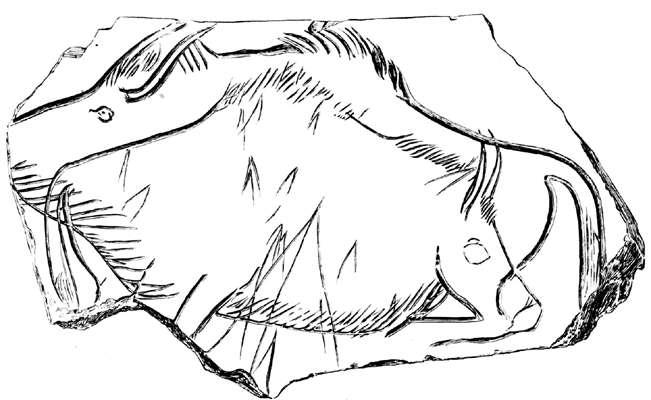
A plate of pink sandstone bears two crossed Bisons almost intact, each with a slightly different attitude, but also interesting for the power and realism of the drawing. Many more or less simplified arrows are engraved on the area that is the common side of the two Bisons.
Photo: De Saint-Périer (1935)

Although animals were the main theme of the artist at Isturitz, as in most Magdalenian deposits, man was sometimes represented.
But his image has not been executed with more felicity than at Isturitz, with this depiction of a man with a beard and a big eye.
Photo: De Saint-Périer (1935)
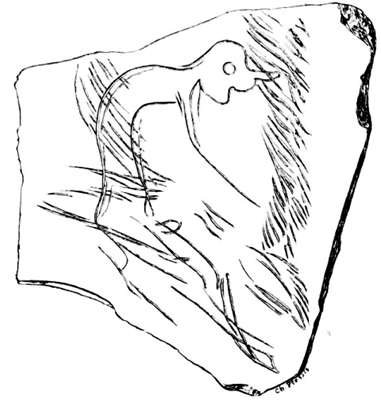
The character on the left is frankly ludicrous, with an enormous nose, drawn over the top of a drawing of a horse which may be seen clearly if the engraving is rotated.
Photo: De Saint-Périer (1935)

The general inferiority of anthropomorphic representations has more to do with lack of care and interest. The people of the time were hunters, and to them the other animals were more important than their own kind, reflected in the superb quality of many animal representations.
(this figure may be wearing some sort of mask - Don)
Photo: De Saint-Périer (1935)
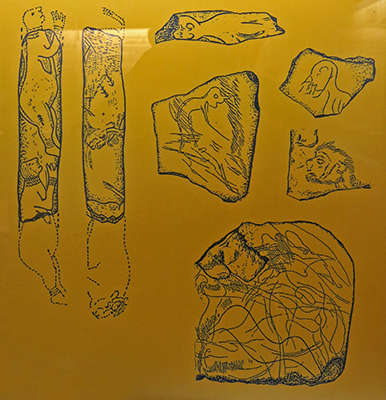
There are a number of interesting representations of humans and anthropomorphic figures represented in the artefacts found in the cave.
Photo: Don Hitchcock 2014
Source: Display, Grottes d'Isturitz et Oxocelhaya
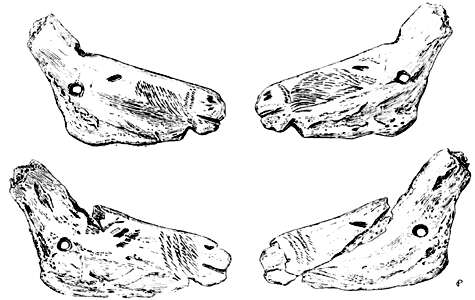
The method of carving a bone to the shape of an animal is represented by many works at Isturitz, mostly horse heads. They are almost all perforated, which suggests they could be used as pendants. They are obtained by cutting the base of the larger part of a horse hyoid bone, whose contour in this region is reminiscent of the shape of a horse. All that needs to be done is to carve the ends to more closely resemble the shape of a horse's head, and to carve the details of the face.
But precisely because of the natural shape of the bone, elongated and concave, these heads are of very uneven artistic quality, depending on the corrections of the bone made by the artist. Here are two examples where the head is a little short, but the details of the nose, eyes and hair are rendered quite well.
Photo: De Saint-Périer (1935)

Another, fragmented in ancient times, would have been too long if the ends had not been broken off, and it thus lacks an eye and an ear, but the mouth and mandible are powerful art.
(note the remnants of two holes. This looks like it could have been a toggle on clothing, and possibly originally had four holes to help fulfil this function - Don)
Photo: De Saint-Périer (1935)

This horse's head is more complete, because here one no longer recognises the outline of the hyoid bone with its convexity on one side and concavity on the other, and it has gained a good resemblance to the horse.
In addition, the two sides have been carefully designed. The head is massive, with a shaggy beard on the lower jaw, and a whole set of punctuation marks and incisions show the hair and the muscles. It exudes a feeling of intense life.
Photo: De Saint-Périer (1935)
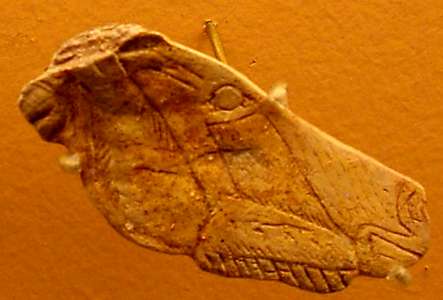
This appears to be a facsimile of the find above.
Photo: Kathy King 2010
Source: Facsimile, display at Musée d'Archeologie Nationale et Domaine, St-Germain-en-Laye
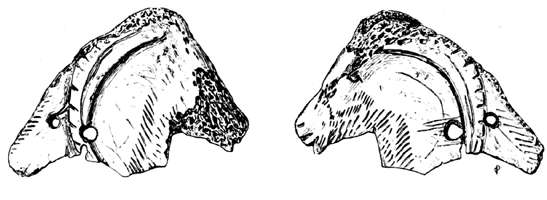
If the horse is the animal most often represented in découpage, where the shape of the animal is shown by the outline on the flat bone on which it is carved as though cut out from paper, at Isturitz there are other animal species represented, including a profile, beard and large corrugated horn of an ibex treated with great accuracy. Animal representation by découpage is rare in Paleolithic art.
Photo: De Saint-Périer (1935)
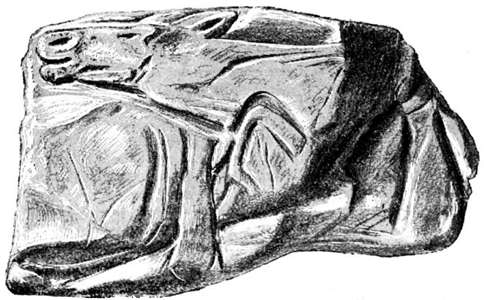
Isturitz provides many examples of sandstone sculptures. First we shall look at the deep engravings, true bas-reliefs, on small blocks of sandstone.
On one of them, we see the front of a reindeer, neck outstretched, mouth open, nostrils quivering, legs bent as if about to collapse. The attitude is that of an animal bellowing, as cervids do in rut. In front of this animal are two legs probably belonging to a horse, which may be distinguished by turning the object.
Photo: De Saint-Périer (1935)

Real sculpture in the round was also used at Isturitz, either as isolated heads, or, more rarely, whole bodies. It was one of these which alarmed the fertiliser merchants into thinking that the cave at Isturitz had some scientific interest.
One example is this long and thin horse's head, where the contours of the jaw, the top of the head and the mane remain well-defined, despite the deterioration suffered while in the ground. It is complete, showing no sign of fracture.
View in profile, 1 and 4, above and below, 2 and 3.
Photo: De Saint-Périer (1935)
(the drawing by Breuil mentioned below was not included in the paper, and I have been unable to locate an image - Don)
This sculpture, where we see a Lynx, is now lost and is known only by a drawing by Abbé Breuil from a photograph which was communicated to him at the time of discovery and which showed, in addition, a human jaw, which allowed Abbé Breuil to assess fairly accurately the size of the sculpture.
Les oiseaux d'Isturitz
The birds of Isturitz
Bouchud (1952)
In the Basque Country, south-west of the village of Isturitz (Canton d'Hasparren, arrondissement de Bayonne), stands a hill of Aptian (lower Cretaceous) limestone and near the top is the cave known as Isturitz. It comprises two parts: the "Salle Saint-Martin" and the "Grande Salle". In this work, we study the birds found in the Aurignacian levels thereof. The remains found there were almost all carried there by man, because the layer without human artefacts contains only very few examples, and most of the bones are not broken in the manner of the remains of meals of large raptors.
| Middle Aurignacian | ||
|---|---|---|
| Number | Species | Common Name |
| 1 | Anas platyrhynchus | Mallard Duck |
| 1 | Buteo ferox (now rufinus) | Long-legged Buzzard |
| 3 | Corvus corax | Common Raven |
| 4 | Corvids sp. | |
| 1 | Falco peregrinus | Peregrine Falcon |
| 1 | Falco tinnunculus | Common Kestrel |
| 2 | Lyrurus tetrix | Black Grouse |
| 1 | Mergus serrator | Red-breasted Merganser |
| 6 | Pyrrhocorax alpinus | Alpine Chough |
| 1 | Pyrrhocorax pyrrhocorax | Red-billed Chough |
| 1 | Spatula clypeata | Northern Shoveler |
| 1 | Tadorna tadorna | Common Shelduck |
| 2 | Tetrao urogallus | Western Capercaillie |
| Total 25 | (12 species) | |
| Final Aurignacian | ||
|---|---|---|
| Number | Species | Common Name |
| 2 | Anas platyrhynchus | Mallard Duck |
| 2 | Coleus monedula | Jackdaw |
| 2 | Corvus corax | Common Raven |
| 3 | Corvids sp. | |
| 1 | Falco tinnunculus | Common Kestrel |
| 1 | Lagopus albus | Willow Grouse |
| 1 | Mergus serrator | Red-breasted Merganser |
| 9 | Pyrrhocorax alpinus | Alpine Chough |
| 1 | Pyrrhocorax pyrrhocorax | Red-billed Chough |
| Total 22 | (8 species) | |
| Superior Aurignacian | ||
|---|---|---|
| Number | Species | Common Name |
| 1 | Aegypius monachus | Black Vulture |
| 1 | Aquila chrysaetos | Golden Eagle |
| 2 | Buteo buteo | Common Buzzard |
| 1 | Buteo lagopus | Rough-legged Buzzard |
| 2 | Coleus monedula | Jackdaw |
| 2 | Corvus corax | Common Raven |
| 3 | Corvids sp. | |
| 1 | Falco peregrinus | Peregrine Falcon |
| 1 | Falco tinnunculus | Common Kestrel |
| 1 | Gyps fulvus | Griffon Vulture |
| 1 | Lagopus mutus | Rock Ptarmigan |
| 1 | Lyrurus tetrix | Black Grouse |
| 1 | Mergus serrator | Red-breasted Merganser |
| 1 | Nucifraga caryocatactes | Spotted Nutcracker |
| 2 | Nyctea nyctea | Snowy Owl |
| 1 | Otus scops | Scops Owl |
| 1 | Oidemia fusca | Velvet Duck |
| 7 | Pyrrhocorax alpinus | Alpine Chough |
| 2 | Pyrrhocorax pyrrhocorax | Red-billed Chough |
| 1 | Turdus torquatus | Ring Ouzel |
| 1 | Tyto alba | Barn Owl |
| Total 34 | (20 species) | |
References
- Anderl, C. and Eifring, H., (eds) 2006, Studies in Chinese Language and Culture - Festschrift in Honour of Christoph Harbsmeier on the Occasion of His 60th Birthday, published by Hermes Academic Publishing, Oslo, 2006, xlvi + 474 pages, including 14 colour pictures, ISBN 82-8034-051-3.
- Antón, M., Salesa, M., Turner, A., Galobart, A., & Pastor, J., 2009, Soft tissue reconstruction of Homotherium latidens (Mammalia, Carnivora, Felidae). Implications for the possibility of representations in Palaeolithic art, Geobios, 42 (5), 541-551.
- Bahn, P., Vertut J., 1997: Journey through the ice age, University of California Press, 1997
- Beck, C., Chantret F. et Sacchi D., 1987: L'Ambre paléolithique de la grotte d’Aurensan (Hautes-Pyrénées). L'Anthropologie 91, 259–62.
- Bello, S., Parfitt S. et Stringer C., 2011: Earliest Directly-Dated Human Skull-CupsPLoS ONE 6(2): e17026. doi:10.1371/journal.pone.0017026
- Bouchud J., 1952: Les oiseaux d'Isturitz. Bulletin de la Société préhistorique française, 1952, tome 49, N. 8. pp. 450-459.
- Buisson, D., 1990: Les flûtes paléolithique d'Isturitz (Pyrénées-Atlantiques), Bulletin de la Société Préhistorique Française, Volume 87, Number 10-12, published by the Société préhistorique française, Paris, in French, 1990, pages 420-433. ISSN 0249-7638.
- Buisson, D., Gambier D., 1990: Façonnage et gravures sur des os humains d'Isturitz (Pyrénées-Atlantiques), Bulletin de la Société Préhistorique Française,1991, tome 88, N. 6. pp. 172-177.
- Delarue, R., Vignard E., 1959: Le grattoir-bec : un nouvel outil du Paléolithique supérieur, Bulletin de la Société Préhistorique Française,1959, Année 1959 56-5-6 pp. 358-363
- D'Errico, F., Henshilwood C., Lawson, G., Vanhaeren, M., Tillier, A., Soressi, M., Bresson, F., Maureille, B., Nowell, A., Lakarra, J., Backwell, L., Julien, M.,., 2003: Archaeological Evidence for the Emergence of Language, Symbolism, and Music — An Alternative Multidisciplinary Perspective, Journal of World Prehistory, Volume 17, Number 1, published by Plenum Publishing Corporation, March 2003, pages 1-70.
- De Saint-Périer, R., 1935: Quelques oeuvres d'art de la grotte d'Isturitz, Bulletin de la Société préhistorique française. 1935, tome 32, N. 1. pp. 64-77.
- Garate, D. Labarge A., Rivero O., Normand C., Darricau J., 2013: The Cave of Isturitz (West Pyrenees, France): One Century of Research in Paleolithic Parietal Art, Arts, 2013, 2, 253-272; doi:10.3390/arts2040253
- LaCarrière, J., Goutas N., Normand C., Simonet A., 2011: des occupations gravettiennes de la grotte d’Isturitz (Pyrénées-Atlantiques, France) : révision critique des collections «anciennes» par l’approche intégrée des données lithiques, fauniques et de l’industrie osseuse, Mémoire LII de la Société préhistorique française
- Laplace, G., 1984: Grotte d'Isturitz, in L’art des cavernes. 1984; pp. 280–282.
- Larribau, J., Prudhomme S., 1983: La grotte ornée d'Erberua (Pyrénées-Atlantiques). Note préliminaire, Bulletin de la Société préhistorique française. 1983, tome 80, N. 9. pp. 280-284.
- Larribau, J., 2011: La Grotte d'Oxocelhaya
- Le Mort, F., 1981: Dégradations artificielles sur des os humains du Paéolithique, PhD, Université Pierre et Marie Curie, Paris.
- Mair, H., 2006: Prehistoric European and East Asian Flutes, in Anderl et al (2006), pages 209-216.
- Normand C., 2002: Isturitz (Salle de Saint-Martin), Rapport de fouille programmée 2000-2002, Bordeaux, Service régional de l'Archéologie d’Aquitaine, 115 p.
- Normand C., 2005: Les Occupations aurignaciennes de la grotte d'Isturitz (Saint-Martin-d'Arberou; Pyrénées-Atlantiques; France), Munibe (Antropologia-Arkeologia) 57, Homenaje a Jesús Altuna 119-129 San Sebastian 2005
- Normand, C. et al., 2007: Nouvelles données sur la séquence aurignacienne de la grotte d’Isturitz (com- munes d’Isturitz et de Saint-Martin-d’Arberoue. Pyrénées-Atlantiques), Actes du Congrès Préhistorique de France, XXVIe session, Congrès du Centenaire, 21-25 septembre 2004, Avignon., Mémoires de la Société préhistorique française, pp.277-293, 2007. halshs-00720561
- Passemard, E., 1913: Fouilles à Isturitz (Basses-Pyrénées), Bulletin de la Société préhistorique française, 1913, tome 10, N. 11. pp. 647-649.
- Passemard, E., 1918: Les sculptures pariétales de la caverne d'Isturitz, Bulletin de la Société préhistorique française, 1918, 15, 466–467
- Passemard, E., 1920: Les Spirales de la caverne d'Isturitz, Bulletin de la Société préhistorique française, 1920, tome 17, N. 6. pp. 150-154.
- Passemard, E., 1920b: Une gravure de lièvre d'Isturitz, Bulletin de la Société préhistorique française, 1920, tome 17, N. 3. pp. 79-81.
- Passemard, E., 1944: La caverne d'Isturitz en Pays Basque, Préhistoire, 1944, 9, 7–95
- Pétillon J., 2008: First evidence of a whale-bone industry in the western European Upper Paleolithic: Magdalenian artifacts from Isturitz (Pyrénées-Atlantiques, France). Journal of Human Evolution, 54 (5): 720-726. doi:10.1016/j.jhevol.2007.12.006
- Saint-Périer, R. & S., 1952: La grotte d'Isturitz: les Solutréens, les Aurignaciens et les Moustériens. Paris : Masson, 264 p., 135 fig., XI pl. h.-t. (Archives de l’Institut de Paléontologie humaine: mémoire n°25)
- San Juan-Foucher, C., 2005: Industrie osseuse décorée du Gravettien des PyrénéesMunibe (Antropologia-Arkeologia) 57Homenaje a Jesús Altuna 95-111 San Sebastian 2005 ISSN 1132-2217
- Sacchi, D., 2003: Engraved Magdalenian plaquettes: a regional and stylistic analysis of stone, bone and antler plaquettes from Upper Palaeolithic sites in France and Cantabric Spain, Oxford: British Archaeological Reports (International Series) 369
- Szmidt C., Normand C., Burr G., Hodgins G. and LaMotta S., 2010: AMS 14C dating the Protoaurignacian/Early Aurignacian of Isturitz, France. Implications for Neanderthal–modern human interaction and the timing of technical and cultural innovations in Europe, Journal of Archaeological Science Volume 37, Issue 4, April 2010, Pages 758-768
- White, R., 2007: Systems of Personal Ornamentation in the Early Upper Palaeolithic: Methodological Challenges and New Observations, Ch 24, http://www.scribd.com/doc/17111147/systems-of-personal-ornamentationpaleolithic
Back to Don's Maps
 Back to Archaeological Sites
Back to Archaeological Sites
